Perception of student nurses' bullying behaviors and coping strategies used in clinical settings
VerifiedAdded on 2023/04/21
|19
|6060
|162
AI Summary
This assignment discusses two research articles on bullying in nursing education. The first article is a qualitative study exploring the bullying experience of Finnish health care students in clinical training. The second article focuses on the perception of student nurses' bullying behaviors and coping strategies in clinical settings. Both articles aim to address the impact of bullying and provide insights on how to address the issue.
Contribute Materials
Your contribution can guide someone’s learning journey. Share your
documents today.
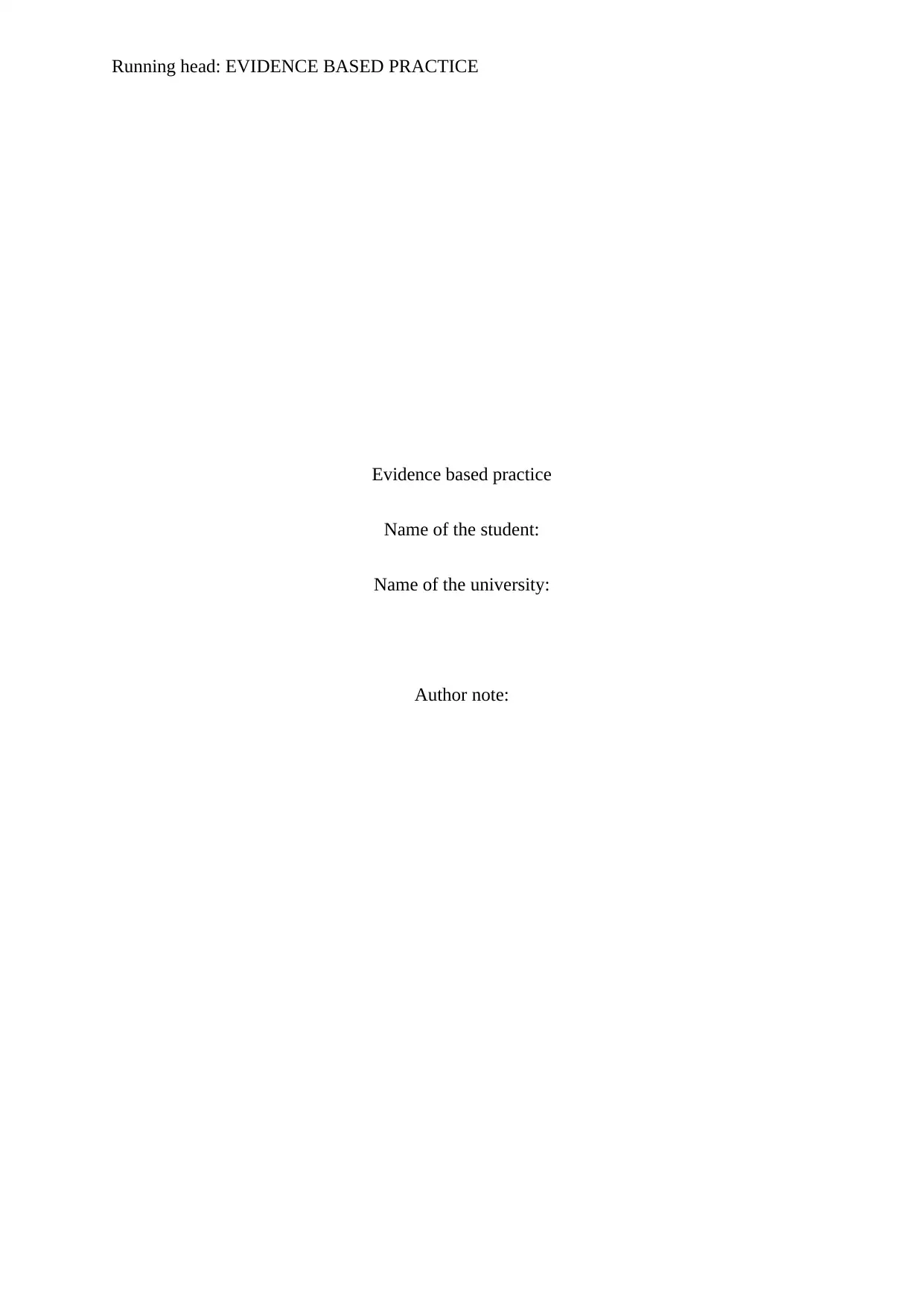
Running head: EVIDENCE BASED PRACTICE
Evidence based practice
Name of the student:
Name of the university:
Author note:
Evidence based practice
Name of the student:
Name of the university:
Author note:
Secure Best Marks with AI Grader
Need help grading? Try our AI Grader for instant feedback on your assignments.
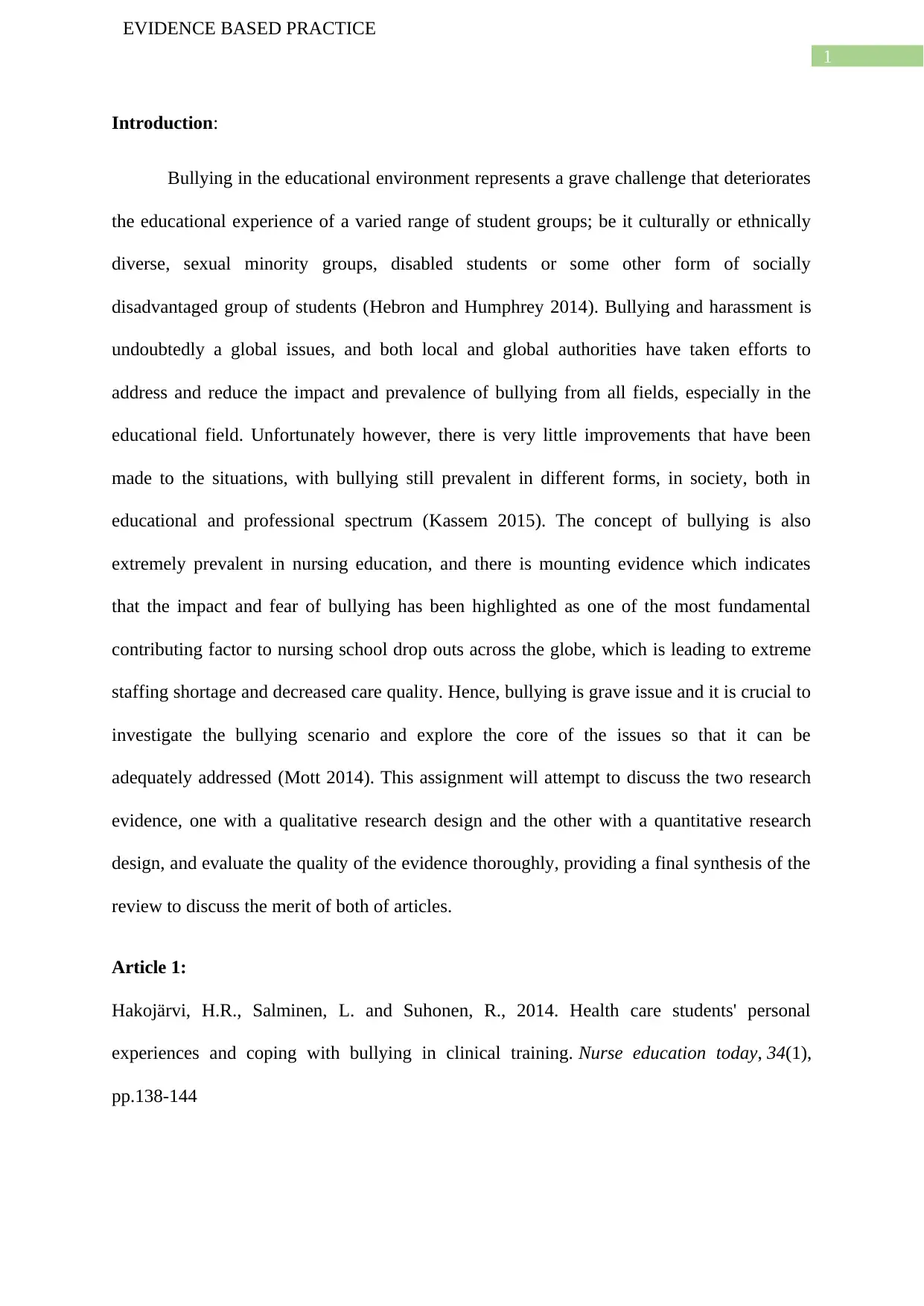
1
EVIDENCE BASED PRACTICE
Introduction:
Bullying in the educational environment represents a grave challenge that deteriorates
the educational experience of a varied range of student groups; be it culturally or ethnically
diverse, sexual minority groups, disabled students or some other form of socially
disadvantaged group of students (Hebron and Humphrey 2014). Bullying and harassment is
undoubtedly a global issues, and both local and global authorities have taken efforts to
address and reduce the impact and prevalence of bullying from all fields, especially in the
educational field. Unfortunately however, there is very little improvements that have been
made to the situations, with bullying still prevalent in different forms, in society, both in
educational and professional spectrum (Kassem 2015). The concept of bullying is also
extremely prevalent in nursing education, and there is mounting evidence which indicates
that the impact and fear of bullying has been highlighted as one of the most fundamental
contributing factor to nursing school drop outs across the globe, which is leading to extreme
staffing shortage and decreased care quality. Hence, bullying is grave issue and it is crucial to
investigate the bullying scenario and explore the core of the issues so that it can be
adequately addressed (Mott 2014). This assignment will attempt to discuss the two research
evidence, one with a qualitative research design and the other with a quantitative research
design, and evaluate the quality of the evidence thoroughly, providing a final synthesis of the
review to discuss the merit of both of articles.
Article 1:
Hakojärvi, H.R., Salminen, L. and Suhonen, R., 2014. Health care students' personal
experiences and coping with bullying in clinical training. Nurse education today, 34(1),
pp.138-144
EVIDENCE BASED PRACTICE
Introduction:
Bullying in the educational environment represents a grave challenge that deteriorates
the educational experience of a varied range of student groups; be it culturally or ethnically
diverse, sexual minority groups, disabled students or some other form of socially
disadvantaged group of students (Hebron and Humphrey 2014). Bullying and harassment is
undoubtedly a global issues, and both local and global authorities have taken efforts to
address and reduce the impact and prevalence of bullying from all fields, especially in the
educational field. Unfortunately however, there is very little improvements that have been
made to the situations, with bullying still prevalent in different forms, in society, both in
educational and professional spectrum (Kassem 2015). The concept of bullying is also
extremely prevalent in nursing education, and there is mounting evidence which indicates
that the impact and fear of bullying has been highlighted as one of the most fundamental
contributing factor to nursing school drop outs across the globe, which is leading to extreme
staffing shortage and decreased care quality. Hence, bullying is grave issue and it is crucial to
investigate the bullying scenario and explore the core of the issues so that it can be
adequately addressed (Mott 2014). This assignment will attempt to discuss the two research
evidence, one with a qualitative research design and the other with a quantitative research
design, and evaluate the quality of the evidence thoroughly, providing a final synthesis of the
review to discuss the merit of both of articles.
Article 1:
Hakojärvi, H.R., Salminen, L. and Suhonen, R., 2014. Health care students' personal
experiences and coping with bullying in clinical training. Nurse education today, 34(1),
pp.138-144
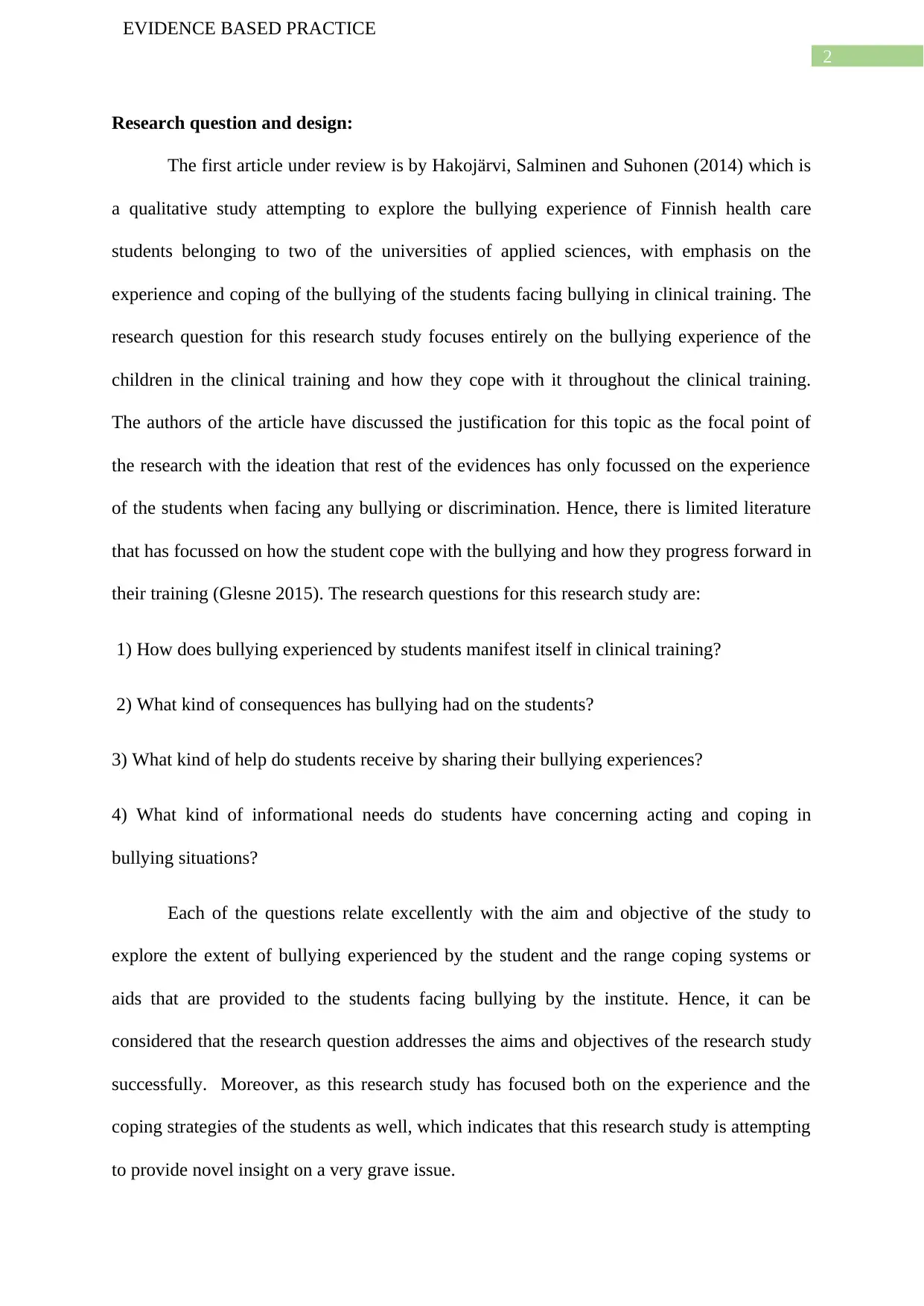
2
EVIDENCE BASED PRACTICE
Research question and design:
The first article under review is by Hakojärvi, Salminen and Suhonen (2014) which is
a qualitative study attempting to explore the bullying experience of Finnish health care
students belonging to two of the universities of applied sciences, with emphasis on the
experience and coping of the bullying of the students facing bullying in clinical training. The
research question for this research study focuses entirely on the bullying experience of the
children in the clinical training and how they cope with it throughout the clinical training.
The authors of the article have discussed the justification for this topic as the focal point of
the research with the ideation that rest of the evidences has only focussed on the experience
of the students when facing any bullying or discrimination. Hence, there is limited literature
that has focussed on how the student cope with the bullying and how they progress forward in
their training (Glesne 2015). The research questions for this research study are:
1) How does bullying experienced by students manifest itself in clinical training?
2) What kind of consequences has bullying had on the students?
3) What kind of help do students receive by sharing their bullying experiences?
4) What kind of informational needs do students have concerning acting and coping in
bullying situations?
Each of the questions relate excellently with the aim and objective of the study to
explore the extent of bullying experienced by the student and the range coping systems or
aids that are provided to the students facing bullying by the institute. Hence, it can be
considered that the research question addresses the aims and objectives of the research study
successfully. Moreover, as this research study has focused both on the experience and the
coping strategies of the students as well, which indicates that this research study is attempting
to provide novel insight on a very grave issue.
EVIDENCE BASED PRACTICE
Research question and design:
The first article under review is by Hakojärvi, Salminen and Suhonen (2014) which is
a qualitative study attempting to explore the bullying experience of Finnish health care
students belonging to two of the universities of applied sciences, with emphasis on the
experience and coping of the bullying of the students facing bullying in clinical training. The
research question for this research study focuses entirely on the bullying experience of the
children in the clinical training and how they cope with it throughout the clinical training.
The authors of the article have discussed the justification for this topic as the focal point of
the research with the ideation that rest of the evidences has only focussed on the experience
of the students when facing any bullying or discrimination. Hence, there is limited literature
that has focussed on how the student cope with the bullying and how they progress forward in
their training (Glesne 2015). The research questions for this research study are:
1) How does bullying experienced by students manifest itself in clinical training?
2) What kind of consequences has bullying had on the students?
3) What kind of help do students receive by sharing their bullying experiences?
4) What kind of informational needs do students have concerning acting and coping in
bullying situations?
Each of the questions relate excellently with the aim and objective of the study to
explore the extent of bullying experienced by the student and the range coping systems or
aids that are provided to the students facing bullying by the institute. Hence, it can be
considered that the research question addresses the aims and objectives of the research study
successfully. Moreover, as this research study has focused both on the experience and the
coping strategies of the students as well, which indicates that this research study is attempting
to provide novel insight on a very grave issue.
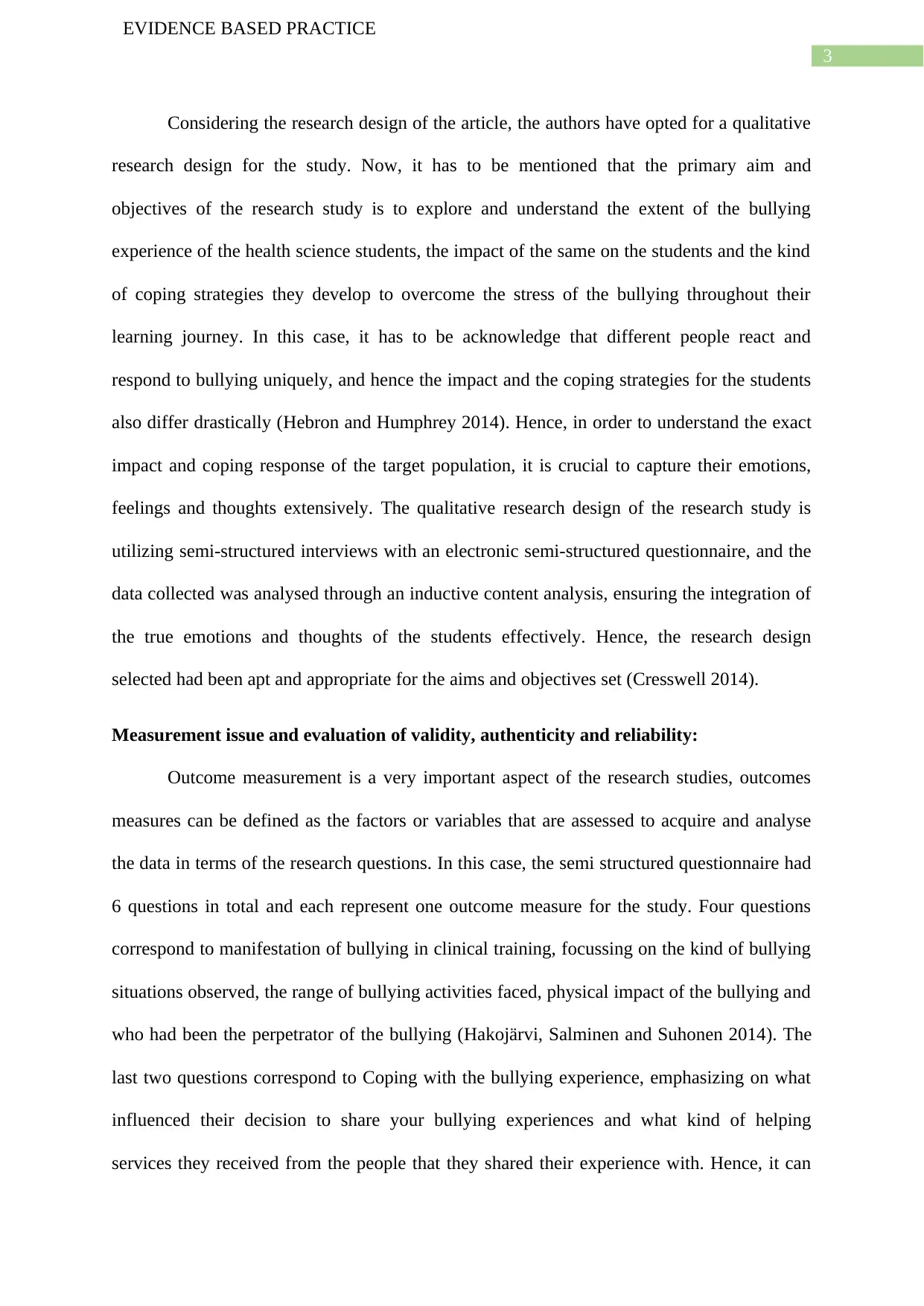
3
EVIDENCE BASED PRACTICE
Considering the research design of the article, the authors have opted for a qualitative
research design for the study. Now, it has to be mentioned that the primary aim and
objectives of the research study is to explore and understand the extent of the bullying
experience of the health science students, the impact of the same on the students and the kind
of coping strategies they develop to overcome the stress of the bullying throughout their
learning journey. In this case, it has to be acknowledge that different people react and
respond to bullying uniquely, and hence the impact and the coping strategies for the students
also differ drastically (Hebron and Humphrey 2014). Hence, in order to understand the exact
impact and coping response of the target population, it is crucial to capture their emotions,
feelings and thoughts extensively. The qualitative research design of the research study is
utilizing semi-structured interviews with an electronic semi-structured questionnaire, and the
data collected was analysed through an inductive content analysis, ensuring the integration of
the true emotions and thoughts of the students effectively. Hence, the research design
selected had been apt and appropriate for the aims and objectives set (Cresswell 2014).
Measurement issue and evaluation of validity, authenticity and reliability:
Outcome measurement is a very important aspect of the research studies, outcomes
measures can be defined as the factors or variables that are assessed to acquire and analyse
the data in terms of the research questions. In this case, the semi structured questionnaire had
6 questions in total and each represent one outcome measure for the study. Four questions
correspond to manifestation of bullying in clinical training, focussing on the kind of bullying
situations observed, the range of bullying activities faced, physical impact of the bullying and
who had been the perpetrator of the bullying (Hakojärvi, Salminen and Suhonen 2014). The
last two questions correspond to Coping with the bullying experience, emphasizing on what
influenced their decision to share your bullying experiences and what kind of helping
services they received from the people that they shared their experience with. Hence, it can
EVIDENCE BASED PRACTICE
Considering the research design of the article, the authors have opted for a qualitative
research design for the study. Now, it has to be mentioned that the primary aim and
objectives of the research study is to explore and understand the extent of the bullying
experience of the health science students, the impact of the same on the students and the kind
of coping strategies they develop to overcome the stress of the bullying throughout their
learning journey. In this case, it has to be acknowledge that different people react and
respond to bullying uniquely, and hence the impact and the coping strategies for the students
also differ drastically (Hebron and Humphrey 2014). Hence, in order to understand the exact
impact and coping response of the target population, it is crucial to capture their emotions,
feelings and thoughts extensively. The qualitative research design of the research study is
utilizing semi-structured interviews with an electronic semi-structured questionnaire, and the
data collected was analysed through an inductive content analysis, ensuring the integration of
the true emotions and thoughts of the students effectively. Hence, the research design
selected had been apt and appropriate for the aims and objectives set (Cresswell 2014).
Measurement issue and evaluation of validity, authenticity and reliability:
Outcome measurement is a very important aspect of the research studies, outcomes
measures can be defined as the factors or variables that are assessed to acquire and analyse
the data in terms of the research questions. In this case, the semi structured questionnaire had
6 questions in total and each represent one outcome measure for the study. Four questions
correspond to manifestation of bullying in clinical training, focussing on the kind of bullying
situations observed, the range of bullying activities faced, physical impact of the bullying and
who had been the perpetrator of the bullying (Hakojärvi, Salminen and Suhonen 2014). The
last two questions correspond to Coping with the bullying experience, emphasizing on what
influenced their decision to share your bullying experiences and what kind of helping
services they received from the people that they shared their experience with. Hence, it can
Secure Best Marks with AI Grader
Need help grading? Try our AI Grader for instant feedback on your assignments.
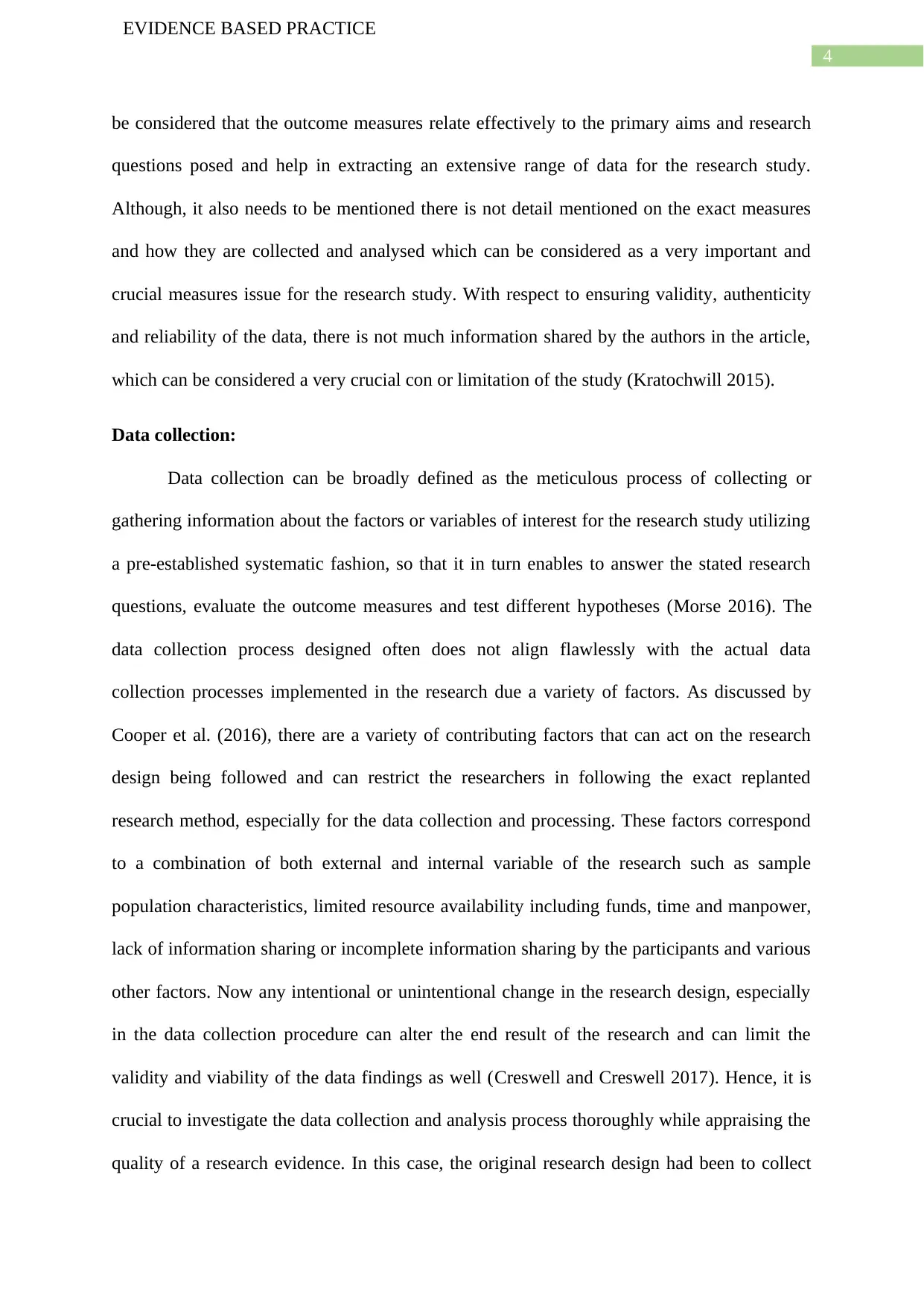
4
EVIDENCE BASED PRACTICE
be considered that the outcome measures relate effectively to the primary aims and research
questions posed and help in extracting an extensive range of data for the research study.
Although, it also needs to be mentioned there is not detail mentioned on the exact measures
and how they are collected and analysed which can be considered as a very important and
crucial measures issue for the research study. With respect to ensuring validity, authenticity
and reliability of the data, there is not much information shared by the authors in the article,
which can be considered a very crucial con or limitation of the study (Kratochwill 2015).
Data collection:
Data collection can be broadly defined as the meticulous process of collecting or
gathering information about the factors or variables of interest for the research study utilizing
a pre-established systematic fashion, so that it in turn enables to answer the stated research
questions, evaluate the outcome measures and test different hypotheses (Morse 2016). The
data collection process designed often does not align flawlessly with the actual data
collection processes implemented in the research due a variety of factors. As discussed by
Cooper et al. (2016), there are a variety of contributing factors that can act on the research
design being followed and can restrict the researchers in following the exact replanted
research method, especially for the data collection and processing. These factors correspond
to a combination of both external and internal variable of the research such as sample
population characteristics, limited resource availability including funds, time and manpower,
lack of information sharing or incomplete information sharing by the participants and various
other factors. Now any intentional or unintentional change in the research design, especially
in the data collection procedure can alter the end result of the research and can limit the
validity and viability of the data findings as well (Creswell and Creswell 2017). Hence, it is
crucial to investigate the data collection and analysis process thoroughly while appraising the
quality of a research evidence. In this case, the original research design had been to collect
EVIDENCE BASED PRACTICE
be considered that the outcome measures relate effectively to the primary aims and research
questions posed and help in extracting an extensive range of data for the research study.
Although, it also needs to be mentioned there is not detail mentioned on the exact measures
and how they are collected and analysed which can be considered as a very important and
crucial measures issue for the research study. With respect to ensuring validity, authenticity
and reliability of the data, there is not much information shared by the authors in the article,
which can be considered a very crucial con or limitation of the study (Kratochwill 2015).
Data collection:
Data collection can be broadly defined as the meticulous process of collecting or
gathering information about the factors or variables of interest for the research study utilizing
a pre-established systematic fashion, so that it in turn enables to answer the stated research
questions, evaluate the outcome measures and test different hypotheses (Morse 2016). The
data collection process designed often does not align flawlessly with the actual data
collection processes implemented in the research due a variety of factors. As discussed by
Cooper et al. (2016), there are a variety of contributing factors that can act on the research
design being followed and can restrict the researchers in following the exact replanted
research method, especially for the data collection and processing. These factors correspond
to a combination of both external and internal variable of the research such as sample
population characteristics, limited resource availability including funds, time and manpower,
lack of information sharing or incomplete information sharing by the participants and various
other factors. Now any intentional or unintentional change in the research design, especially
in the data collection procedure can alter the end result of the research and can limit the
validity and viability of the data findings as well (Creswell and Creswell 2017). Hence, it is
crucial to investigate the data collection and analysis process thoroughly while appraising the
quality of a research evidence. In this case, the original research design had been to collect
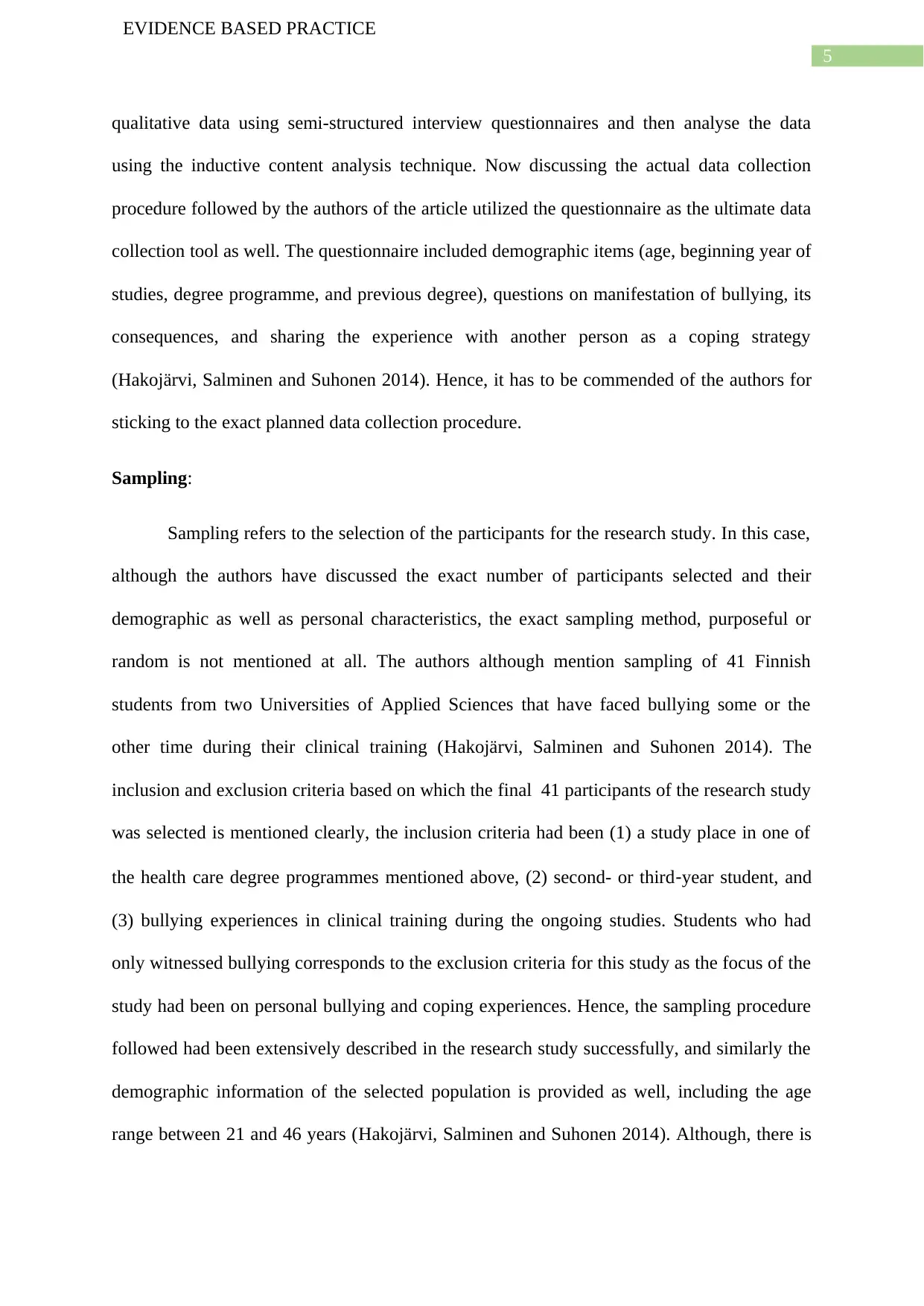
5
EVIDENCE BASED PRACTICE
qualitative data using semi-structured interview questionnaires and then analyse the data
using the inductive content analysis technique. Now discussing the actual data collection
procedure followed by the authors of the article utilized the questionnaire as the ultimate data
collection tool as well. The questionnaire included demographic items (age, beginning year of
studies, degree programme, and previous degree), questions on manifestation of bullying, its
consequences, and sharing the experience with another person as a coping strategy
(Hakojärvi, Salminen and Suhonen 2014). Hence, it has to be commended of the authors for
sticking to the exact planned data collection procedure.
Sampling:
Sampling refers to the selection of the participants for the research study. In this case,
although the authors have discussed the exact number of participants selected and their
demographic as well as personal characteristics, the exact sampling method, purposeful or
random is not mentioned at all. The authors although mention sampling of 41 Finnish
students from two Universities of Applied Sciences that have faced bullying some or the
other time during their clinical training (Hakojärvi, Salminen and Suhonen 2014). The
inclusion and exclusion criteria based on which the final 41 participants of the research study
was selected is mentioned clearly, the inclusion criteria had been (1) a study place in one of
the health care degree programmes mentioned above, (2) second- or third‐year student, and
(3) bullying experiences in clinical training during the ongoing studies. Students who had
only witnessed bullying corresponds to the exclusion criteria for this study as the focus of the
study had been on personal bullying and coping experiences. Hence, the sampling procedure
followed had been extensively described in the research study successfully, and similarly the
demographic information of the selected population is provided as well, including the age
range between 21 and 46 years (Hakojärvi, Salminen and Suhonen 2014). Although, there is
EVIDENCE BASED PRACTICE
qualitative data using semi-structured interview questionnaires and then analyse the data
using the inductive content analysis technique. Now discussing the actual data collection
procedure followed by the authors of the article utilized the questionnaire as the ultimate data
collection tool as well. The questionnaire included demographic items (age, beginning year of
studies, degree programme, and previous degree), questions on manifestation of bullying, its
consequences, and sharing the experience with another person as a coping strategy
(Hakojärvi, Salminen and Suhonen 2014). Hence, it has to be commended of the authors for
sticking to the exact planned data collection procedure.
Sampling:
Sampling refers to the selection of the participants for the research study. In this case,
although the authors have discussed the exact number of participants selected and their
demographic as well as personal characteristics, the exact sampling method, purposeful or
random is not mentioned at all. The authors although mention sampling of 41 Finnish
students from two Universities of Applied Sciences that have faced bullying some or the
other time during their clinical training (Hakojärvi, Salminen and Suhonen 2014). The
inclusion and exclusion criteria based on which the final 41 participants of the research study
was selected is mentioned clearly, the inclusion criteria had been (1) a study place in one of
the health care degree programmes mentioned above, (2) second- or third‐year student, and
(3) bullying experiences in clinical training during the ongoing studies. Students who had
only witnessed bullying corresponds to the exclusion criteria for this study as the focus of the
study had been on personal bullying and coping experiences. Hence, the sampling procedure
followed had been extensively described in the research study successfully, and similarly the
demographic information of the selected population is provided as well, including the age
range between 21 and 46 years (Hakojärvi, Salminen and Suhonen 2014). Although, there is
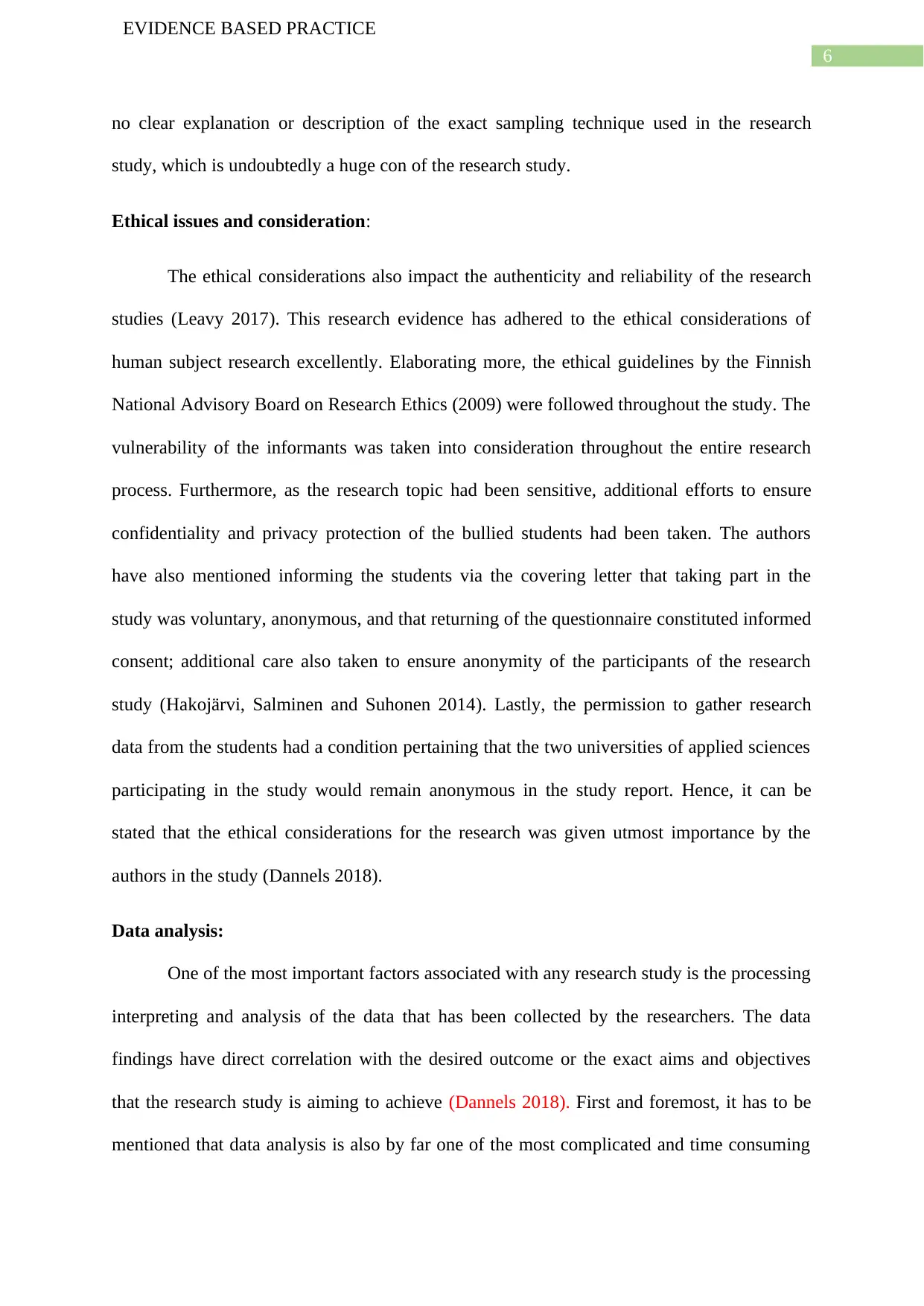
6
EVIDENCE BASED PRACTICE
no clear explanation or description of the exact sampling technique used in the research
study, which is undoubtedly a huge con of the research study.
Ethical issues and consideration:
The ethical considerations also impact the authenticity and reliability of the research
studies (Leavy 2017). This research evidence has adhered to the ethical considerations of
human subject research excellently. Elaborating more, the ethical guidelines by the Finnish
National Advisory Board on Research Ethics (2009) were followed throughout the study. The
vulnerability of the informants was taken into consideration throughout the entire research
process. Furthermore, as the research topic had been sensitive, additional efforts to ensure
confidentiality and privacy protection of the bullied students had been taken. The authors
have also mentioned informing the students via the covering letter that taking part in the
study was voluntary, anonymous, and that returning of the questionnaire constituted informed
consent; additional care also taken to ensure anonymity of the participants of the research
study (Hakojärvi, Salminen and Suhonen 2014). Lastly, the permission to gather research
data from the students had a condition pertaining that the two universities of applied sciences
participating in the study would remain anonymous in the study report. Hence, it can be
stated that the ethical considerations for the research was given utmost importance by the
authors in the study (Dannels 2018).
Data analysis:
One of the most important factors associated with any research study is the processing
interpreting and analysis of the data that has been collected by the researchers. The data
findings have direct correlation with the desired outcome or the exact aims and objectives
that the research study is aiming to achieve (Dannels 2018). First and foremost, it has to be
mentioned that data analysis is also by far one of the most complicated and time consuming
EVIDENCE BASED PRACTICE
no clear explanation or description of the exact sampling technique used in the research
study, which is undoubtedly a huge con of the research study.
Ethical issues and consideration:
The ethical considerations also impact the authenticity and reliability of the research
studies (Leavy 2017). This research evidence has adhered to the ethical considerations of
human subject research excellently. Elaborating more, the ethical guidelines by the Finnish
National Advisory Board on Research Ethics (2009) were followed throughout the study. The
vulnerability of the informants was taken into consideration throughout the entire research
process. Furthermore, as the research topic had been sensitive, additional efforts to ensure
confidentiality and privacy protection of the bullied students had been taken. The authors
have also mentioned informing the students via the covering letter that taking part in the
study was voluntary, anonymous, and that returning of the questionnaire constituted informed
consent; additional care also taken to ensure anonymity of the participants of the research
study (Hakojärvi, Salminen and Suhonen 2014). Lastly, the permission to gather research
data from the students had a condition pertaining that the two universities of applied sciences
participating in the study would remain anonymous in the study report. Hence, it can be
stated that the ethical considerations for the research was given utmost importance by the
authors in the study (Dannels 2018).
Data analysis:
One of the most important factors associated with any research study is the processing
interpreting and analysis of the data that has been collected by the researchers. The data
findings have direct correlation with the desired outcome or the exact aims and objectives
that the research study is aiming to achieve (Dannels 2018). First and foremost, it has to be
mentioned that data analysis is also by far one of the most complicated and time consuming
Paraphrase This Document
Need a fresh take? Get an instant paraphrase of this document with our AI Paraphraser
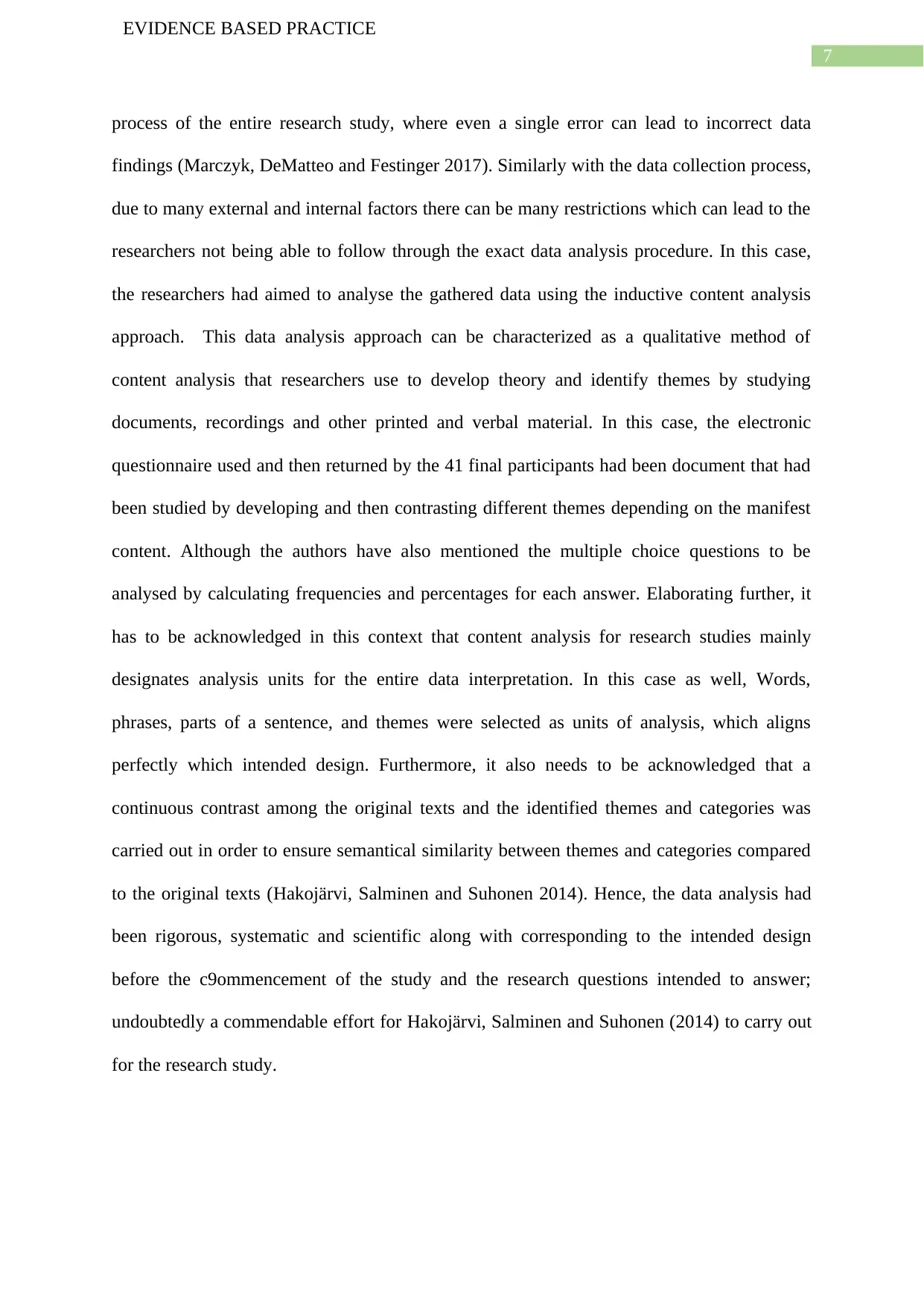
7
EVIDENCE BASED PRACTICE
process of the entire research study, where even a single error can lead to incorrect data
findings (Marczyk, DeMatteo and Festinger 2017). Similarly with the data collection process,
due to many external and internal factors there can be many restrictions which can lead to the
researchers not being able to follow through the exact data analysis procedure. In this case,
the researchers had aimed to analyse the gathered data using the inductive content analysis
approach. This data analysis approach can be characterized as a qualitative method of
content analysis that researchers use to develop theory and identify themes by studying
documents, recordings and other printed and verbal material. In this case, the electronic
questionnaire used and then returned by the 41 final participants had been document that had
been studied by developing and then contrasting different themes depending on the manifest
content. Although the authors have also mentioned the multiple choice questions to be
analysed by calculating frequencies and percentages for each answer. Elaborating further, it
has to be acknowledged in this context that content analysis for research studies mainly
designates analysis units for the entire data interpretation. In this case as well, Words,
phrases, parts of a sentence, and themes were selected as units of analysis, which aligns
perfectly which intended design. Furthermore, it also needs to be acknowledged that a
continuous contrast among the original texts and the identified themes and categories was
carried out in order to ensure semantical similarity between themes and categories compared
to the original texts (Hakojärvi, Salminen and Suhonen 2014). Hence, the data analysis had
been rigorous, systematic and scientific along with corresponding to the intended design
before the c9ommencement of the study and the research questions intended to answer;
undoubtedly a commendable effort for Hakojärvi, Salminen and Suhonen (2014) to carry out
for the research study.
EVIDENCE BASED PRACTICE
process of the entire research study, where even a single error can lead to incorrect data
findings (Marczyk, DeMatteo and Festinger 2017). Similarly with the data collection process,
due to many external and internal factors there can be many restrictions which can lead to the
researchers not being able to follow through the exact data analysis procedure. In this case,
the researchers had aimed to analyse the gathered data using the inductive content analysis
approach. This data analysis approach can be characterized as a qualitative method of
content analysis that researchers use to develop theory and identify themes by studying
documents, recordings and other printed and verbal material. In this case, the electronic
questionnaire used and then returned by the 41 final participants had been document that had
been studied by developing and then contrasting different themes depending on the manifest
content. Although the authors have also mentioned the multiple choice questions to be
analysed by calculating frequencies and percentages for each answer. Elaborating further, it
has to be acknowledged in this context that content analysis for research studies mainly
designates analysis units for the entire data interpretation. In this case as well, Words,
phrases, parts of a sentence, and themes were selected as units of analysis, which aligns
perfectly which intended design. Furthermore, it also needs to be acknowledged that a
continuous contrast among the original texts and the identified themes and categories was
carried out in order to ensure semantical similarity between themes and categories compared
to the original texts (Hakojärvi, Salminen and Suhonen 2014). Hence, the data analysis had
been rigorous, systematic and scientific along with corresponding to the intended design
before the c9ommencement of the study and the research questions intended to answer;
undoubtedly a commendable effort for Hakojärvi, Salminen and Suhonen (2014) to carry out
for the research study.
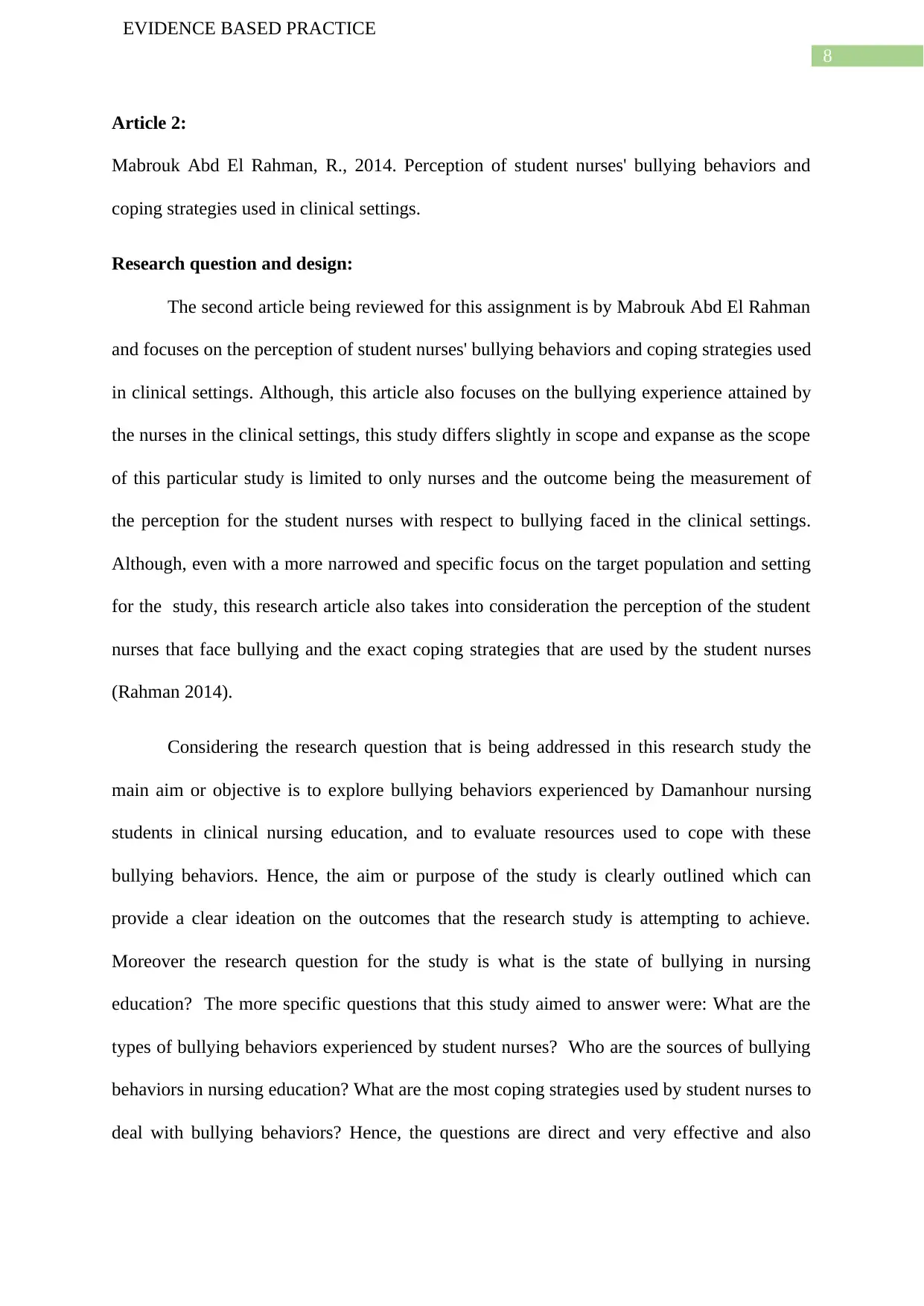
8
EVIDENCE BASED PRACTICE
Article 2:
Mabrouk Abd El Rahman, R., 2014. Perception of student nurses' bullying behaviors and
coping strategies used in clinical settings.
Research question and design:
The second article being reviewed for this assignment is by Mabrouk Abd El Rahman
and focuses on the perception of student nurses' bullying behaviors and coping strategies used
in clinical settings. Although, this article also focuses on the bullying experience attained by
the nurses in the clinical settings, this study differs slightly in scope and expanse as the scope
of this particular study is limited to only nurses and the outcome being the measurement of
the perception for the student nurses with respect to bullying faced in the clinical settings.
Although, even with a more narrowed and specific focus on the target population and setting
for the study, this research article also takes into consideration the perception of the student
nurses that face bullying and the exact coping strategies that are used by the student nurses
(Rahman 2014).
Considering the research question that is being addressed in this research study the
main aim or objective is to explore bullying behaviors experienced by Damanhour nursing
students in clinical nursing education, and to evaluate resources used to cope with these
bullying behaviors. Hence, the aim or purpose of the study is clearly outlined which can
provide a clear ideation on the outcomes that the research study is attempting to achieve.
Moreover the research question for the study is what is the state of bullying in nursing
education? The more specific questions that this study aimed to answer were: What are the
types of bullying behaviors experienced by student nurses? Who are the sources of bullying
behaviors in nursing education? What are the most coping strategies used by student nurses to
deal with bullying behaviors? Hence, the questions are direct and very effective and also
EVIDENCE BASED PRACTICE
Article 2:
Mabrouk Abd El Rahman, R., 2014. Perception of student nurses' bullying behaviors and
coping strategies used in clinical settings.
Research question and design:
The second article being reviewed for this assignment is by Mabrouk Abd El Rahman
and focuses on the perception of student nurses' bullying behaviors and coping strategies used
in clinical settings. Although, this article also focuses on the bullying experience attained by
the nurses in the clinical settings, this study differs slightly in scope and expanse as the scope
of this particular study is limited to only nurses and the outcome being the measurement of
the perception for the student nurses with respect to bullying faced in the clinical settings.
Although, even with a more narrowed and specific focus on the target population and setting
for the study, this research article also takes into consideration the perception of the student
nurses that face bullying and the exact coping strategies that are used by the student nurses
(Rahman 2014).
Considering the research question that is being addressed in this research study the
main aim or objective is to explore bullying behaviors experienced by Damanhour nursing
students in clinical nursing education, and to evaluate resources used to cope with these
bullying behaviors. Hence, the aim or purpose of the study is clearly outlined which can
provide a clear ideation on the outcomes that the research study is attempting to achieve.
Moreover the research question for the study is what is the state of bullying in nursing
education? The more specific questions that this study aimed to answer were: What are the
types of bullying behaviors experienced by student nurses? Who are the sources of bullying
behaviors in nursing education? What are the most coping strategies used by student nurses to
deal with bullying behaviors? Hence, the questions are direct and very effective and also
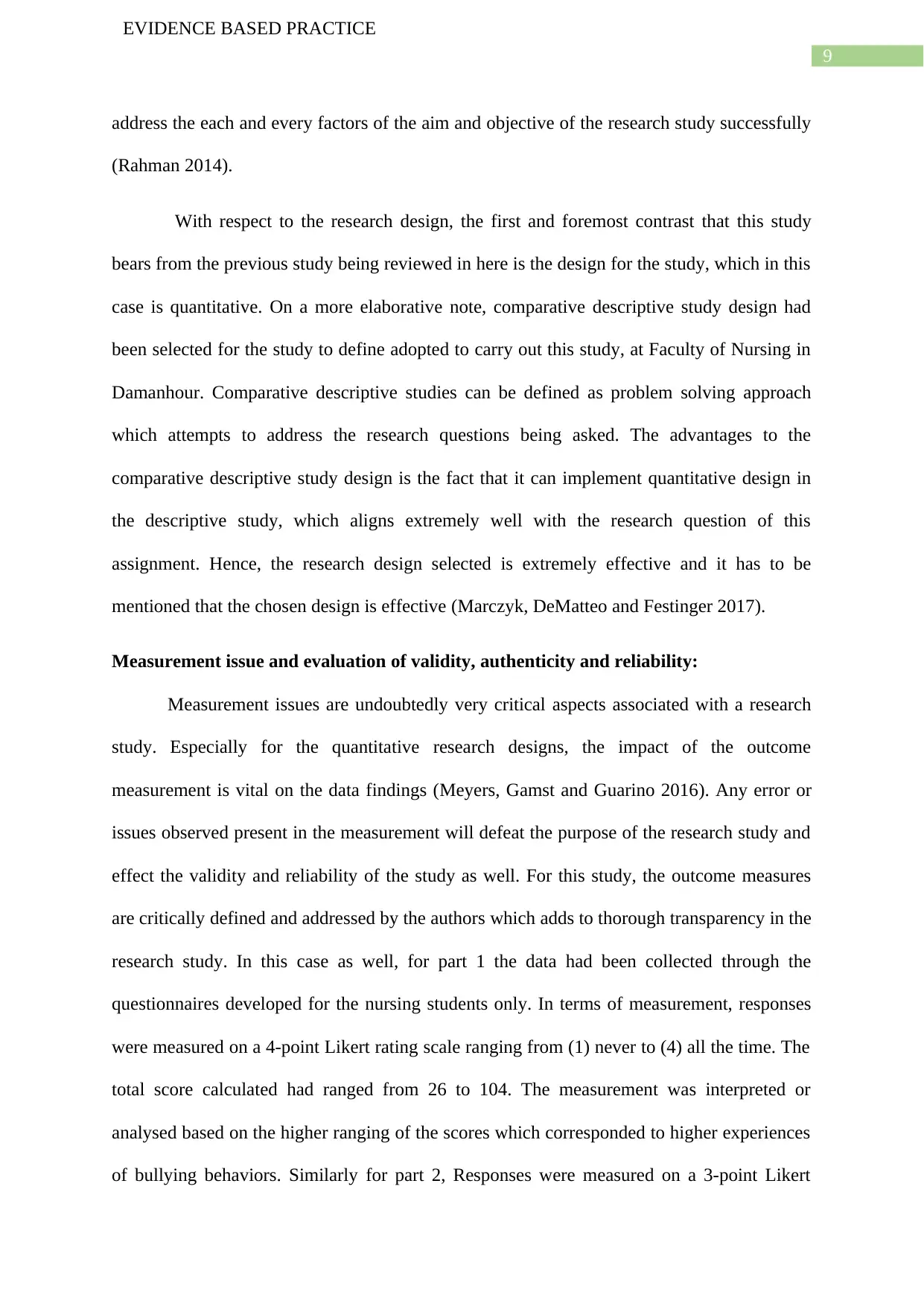
9
EVIDENCE BASED PRACTICE
address the each and every factors of the aim and objective of the research study successfully
(Rahman 2014).
With respect to the research design, the first and foremost contrast that this study
bears from the previous study being reviewed in here is the design for the study, which in this
case is quantitative. On a more elaborative note, comparative descriptive study design had
been selected for the study to define adopted to carry out this study, at Faculty of Nursing in
Damanhour. Comparative descriptive studies can be defined as problem solving approach
which attempts to address the research questions being asked. The advantages to the
comparative descriptive study design is the fact that it can implement quantitative design in
the descriptive study, which aligns extremely well with the research question of this
assignment. Hence, the research design selected is extremely effective and it has to be
mentioned that the chosen design is effective (Marczyk, DeMatteo and Festinger 2017).
Measurement issue and evaluation of validity, authenticity and reliability:
Measurement issues are undoubtedly very critical aspects associated with a research
study. Especially for the quantitative research designs, the impact of the outcome
measurement is vital on the data findings (Meyers, Gamst and Guarino 2016). Any error or
issues observed present in the measurement will defeat the purpose of the research study and
effect the validity and reliability of the study as well. For this study, the outcome measures
are critically defined and addressed by the authors which adds to thorough transparency in the
research study. In this case as well, for part 1 the data had been collected through the
questionnaires developed for the nursing students only. In terms of measurement, responses
were measured on a 4-point Likert rating scale ranging from (1) never to (4) all the time. The
total score calculated had ranged from 26 to 104. The measurement was interpreted or
analysed based on the higher ranging of the scores which corresponded to higher experiences
of bullying behaviors. Similarly for part 2, Responses were measured on a 3-point Likert
EVIDENCE BASED PRACTICE
address the each and every factors of the aim and objective of the research study successfully
(Rahman 2014).
With respect to the research design, the first and foremost contrast that this study
bears from the previous study being reviewed in here is the design for the study, which in this
case is quantitative. On a more elaborative note, comparative descriptive study design had
been selected for the study to define adopted to carry out this study, at Faculty of Nursing in
Damanhour. Comparative descriptive studies can be defined as problem solving approach
which attempts to address the research questions being asked. The advantages to the
comparative descriptive study design is the fact that it can implement quantitative design in
the descriptive study, which aligns extremely well with the research question of this
assignment. Hence, the research design selected is extremely effective and it has to be
mentioned that the chosen design is effective (Marczyk, DeMatteo and Festinger 2017).
Measurement issue and evaluation of validity, authenticity and reliability:
Measurement issues are undoubtedly very critical aspects associated with a research
study. Especially for the quantitative research designs, the impact of the outcome
measurement is vital on the data findings (Meyers, Gamst and Guarino 2016). Any error or
issues observed present in the measurement will defeat the purpose of the research study and
effect the validity and reliability of the study as well. For this study, the outcome measures
are critically defined and addressed by the authors which adds to thorough transparency in the
research study. In this case as well, for part 1 the data had been collected through the
questionnaires developed for the nursing students only. In terms of measurement, responses
were measured on a 4-point Likert rating scale ranging from (1) never to (4) all the time. The
total score calculated had ranged from 26 to 104. The measurement was interpreted or
analysed based on the higher ranging of the scores which corresponded to higher experiences
of bullying behaviors. Similarly for part 2, Responses were measured on a 3-point Likert
Secure Best Marks with AI Grader
Need help grading? Try our AI Grader for instant feedback on your assignments.
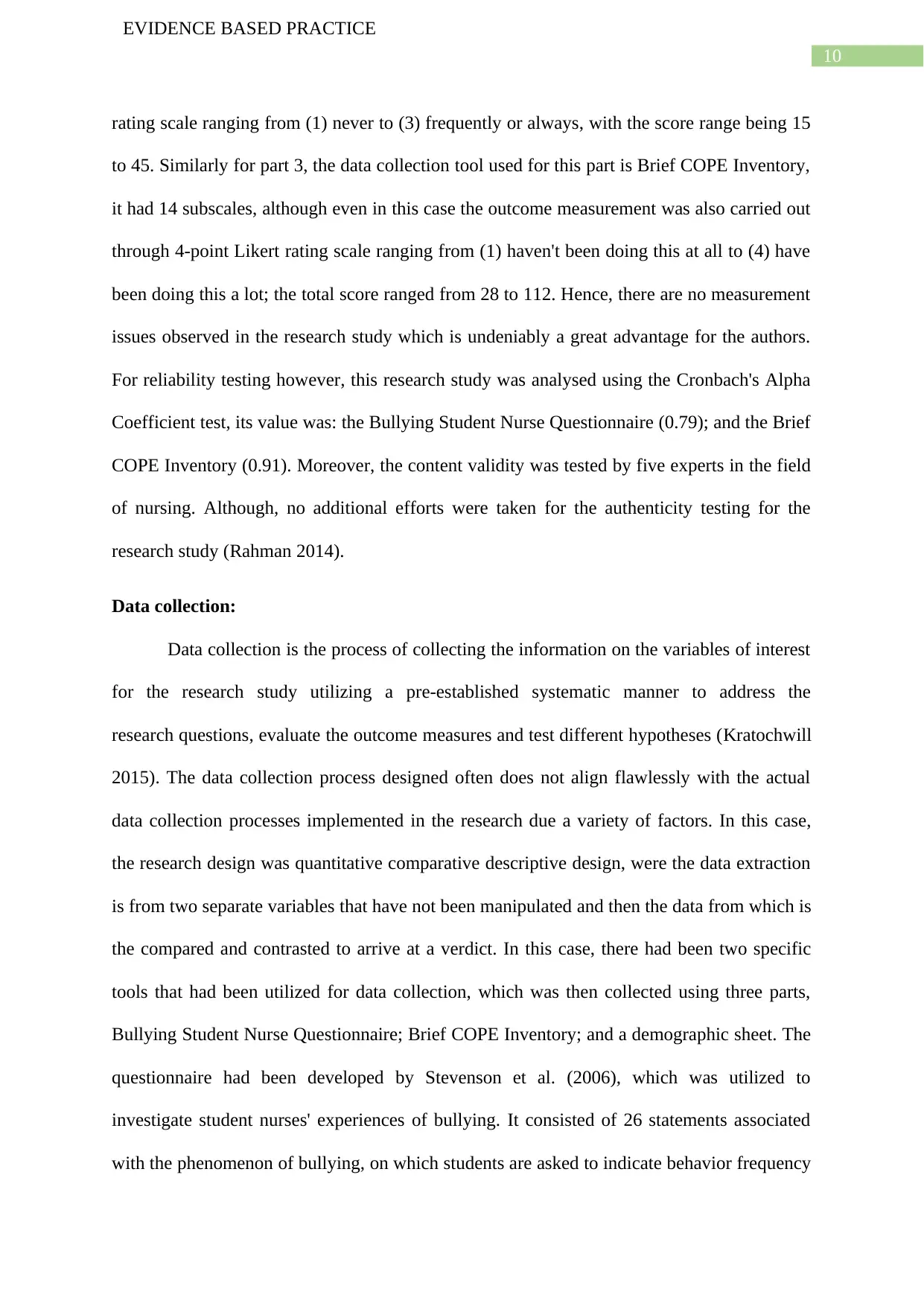
10
EVIDENCE BASED PRACTICE
rating scale ranging from (1) never to (3) frequently or always, with the score range being 15
to 45. Similarly for part 3, the data collection tool used for this part is Brief COPE Inventory,
it had 14 subscales, although even in this case the outcome measurement was also carried out
through 4-point Likert rating scale ranging from (1) haven't been doing this at all to (4) have
been doing this a lot; the total score ranged from 28 to 112. Hence, there are no measurement
issues observed in the research study which is undeniably a great advantage for the authors.
For reliability testing however, this research study was analysed using the Cronbach's Alpha
Coefficient test, its value was: the Bullying Student Nurse Questionnaire (0.79); and the Brief
COPE Inventory (0.91). Moreover, the content validity was tested by five experts in the field
of nursing. Although, no additional efforts were taken for the authenticity testing for the
research study (Rahman 2014).
Data collection:
Data collection is the process of collecting the information on the variables of interest
for the research study utilizing a pre-established systematic manner to address the
research questions, evaluate the outcome measures and test different hypotheses (Kratochwill
2015). The data collection process designed often does not align flawlessly with the actual
data collection processes implemented in the research due a variety of factors. In this case,
the research design was quantitative comparative descriptive design, were the data extraction
is from two separate variables that have not been manipulated and then the data from which is
the compared and contrasted to arrive at a verdict. In this case, there had been two specific
tools that had been utilized for data collection, which was then collected using three parts,
Bullying Student Nurse Questionnaire; Brief COPE Inventory; and a demographic sheet. The
questionnaire had been developed by Stevenson et al. (2006), which was utilized to
investigate student nurses' experiences of bullying. It consisted of 26 statements associated
with the phenomenon of bullying, on which students are asked to indicate behavior frequency
EVIDENCE BASED PRACTICE
rating scale ranging from (1) never to (3) frequently or always, with the score range being 15
to 45. Similarly for part 3, the data collection tool used for this part is Brief COPE Inventory,
it had 14 subscales, although even in this case the outcome measurement was also carried out
through 4-point Likert rating scale ranging from (1) haven't been doing this at all to (4) have
been doing this a lot; the total score ranged from 28 to 112. Hence, there are no measurement
issues observed in the research study which is undeniably a great advantage for the authors.
For reliability testing however, this research study was analysed using the Cronbach's Alpha
Coefficient test, its value was: the Bullying Student Nurse Questionnaire (0.79); and the Brief
COPE Inventory (0.91). Moreover, the content validity was tested by five experts in the field
of nursing. Although, no additional efforts were taken for the authenticity testing for the
research study (Rahman 2014).
Data collection:
Data collection is the process of collecting the information on the variables of interest
for the research study utilizing a pre-established systematic manner to address the
research questions, evaluate the outcome measures and test different hypotheses (Kratochwill
2015). The data collection process designed often does not align flawlessly with the actual
data collection processes implemented in the research due a variety of factors. In this case,
the research design was quantitative comparative descriptive design, were the data extraction
is from two separate variables that have not been manipulated and then the data from which is
the compared and contrasted to arrive at a verdict. In this case, there had been two specific
tools that had been utilized for data collection, which was then collected using three parts,
Bullying Student Nurse Questionnaire; Brief COPE Inventory; and a demographic sheet. The
questionnaire had been developed by Stevenson et al. (2006), which was utilized to
investigate student nurses' experiences of bullying. It consisted of 26 statements associated
with the phenomenon of bullying, on which students are asked to indicate behavior frequency
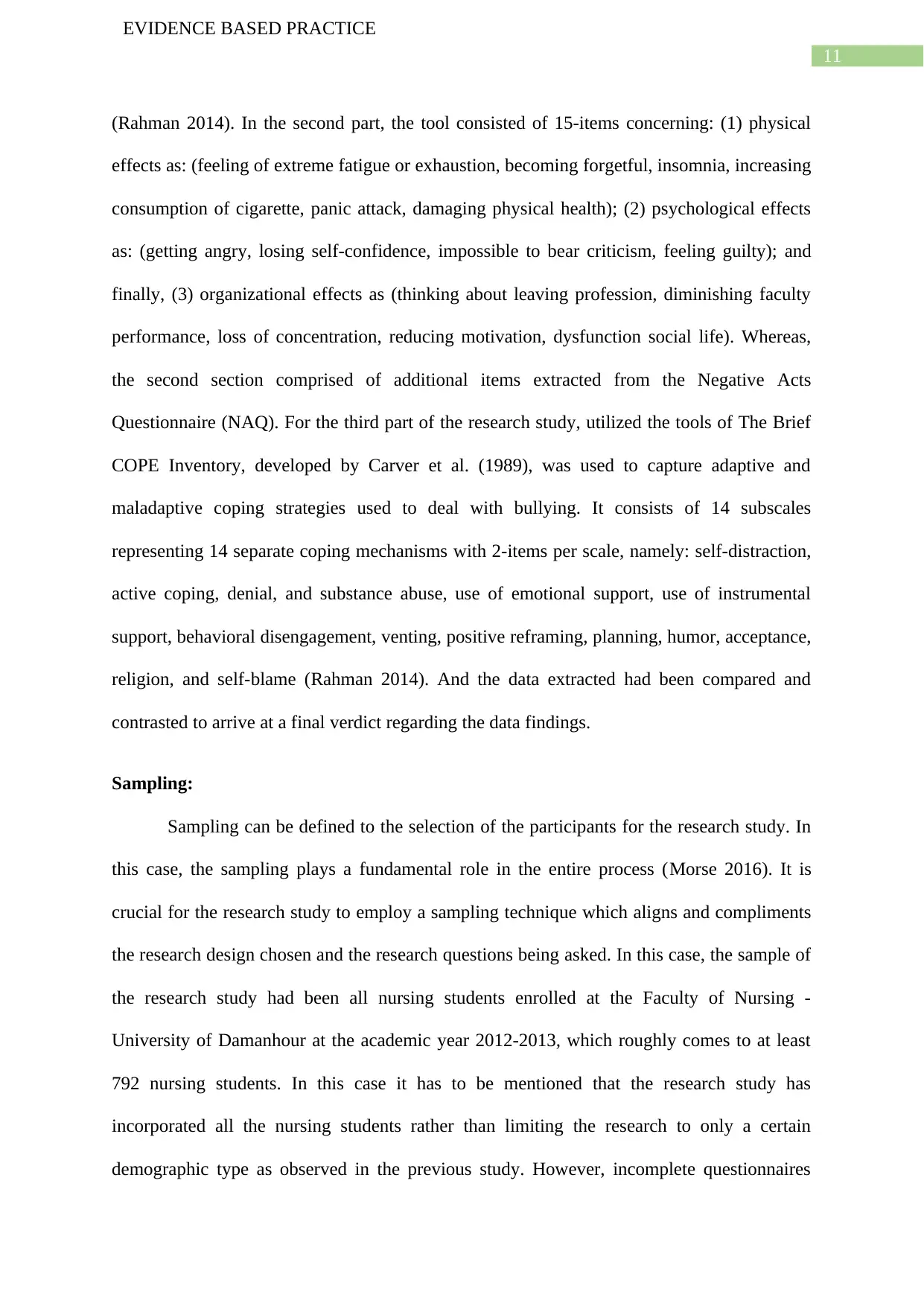
11
EVIDENCE BASED PRACTICE
(Rahman 2014). In the second part, the tool consisted of 15-items concerning: (1) physical
effects as: (feeling of extreme fatigue or exhaustion, becoming forgetful, insomnia, increasing
consumption of cigarette, panic attack, damaging physical health); (2) psychological effects
as: (getting angry, losing self-confidence, impossible to bear criticism, feeling guilty); and
finally, (3) organizational effects as (thinking about leaving profession, diminishing faculty
performance, loss of concentration, reducing motivation, dysfunction social life). Whereas,
the second section comprised of additional items extracted from the Negative Acts
Questionnaire (NAQ). For the third part of the research study, utilized the tools of The Brief
COPE Inventory, developed by Carver et al. (1989), was used to capture adaptive and
maladaptive coping strategies used to deal with bullying. It consists of 14 subscales
representing 14 separate coping mechanisms with 2-items per scale, namely: self-distraction,
active coping, denial, and substance abuse, use of emotional support, use of instrumental
support, behavioral disengagement, venting, positive reframing, planning, humor, acceptance,
religion, and self-blame (Rahman 2014). And the data extracted had been compared and
contrasted to arrive at a final verdict regarding the data findings.
Sampling:
Sampling can be defined to the selection of the participants for the research study. In
this case, the sampling plays a fundamental role in the entire process (Morse 2016). It is
crucial for the research study to employ a sampling technique which aligns and compliments
the research design chosen and the research questions being asked. In this case, the sample of
the research study had been all nursing students enrolled at the Faculty of Nursing -
University of Damanhour at the academic year 2012-2013, which roughly comes to at least
792 nursing students. In this case it has to be mentioned that the research study has
incorporated all the nursing students rather than limiting the research to only a certain
demographic type as observed in the previous study. However, incomplete questionnaires
EVIDENCE BASED PRACTICE
(Rahman 2014). In the second part, the tool consisted of 15-items concerning: (1) physical
effects as: (feeling of extreme fatigue or exhaustion, becoming forgetful, insomnia, increasing
consumption of cigarette, panic attack, damaging physical health); (2) psychological effects
as: (getting angry, losing self-confidence, impossible to bear criticism, feeling guilty); and
finally, (3) organizational effects as (thinking about leaving profession, diminishing faculty
performance, loss of concentration, reducing motivation, dysfunction social life). Whereas,
the second section comprised of additional items extracted from the Negative Acts
Questionnaire (NAQ). For the third part of the research study, utilized the tools of The Brief
COPE Inventory, developed by Carver et al. (1989), was used to capture adaptive and
maladaptive coping strategies used to deal with bullying. It consists of 14 subscales
representing 14 separate coping mechanisms with 2-items per scale, namely: self-distraction,
active coping, denial, and substance abuse, use of emotional support, use of instrumental
support, behavioral disengagement, venting, positive reframing, planning, humor, acceptance,
religion, and self-blame (Rahman 2014). And the data extracted had been compared and
contrasted to arrive at a final verdict regarding the data findings.
Sampling:
Sampling can be defined to the selection of the participants for the research study. In
this case, the sampling plays a fundamental role in the entire process (Morse 2016). It is
crucial for the research study to employ a sampling technique which aligns and compliments
the research design chosen and the research questions being asked. In this case, the sample of
the research study had been all nursing students enrolled at the Faculty of Nursing -
University of Damanhour at the academic year 2012-2013, which roughly comes to at least
792 nursing students. In this case it has to be mentioned that the research study has
incorporated all the nursing students rather than limiting the research to only a certain
demographic type as observed in the previous study. However, incomplete questionnaires
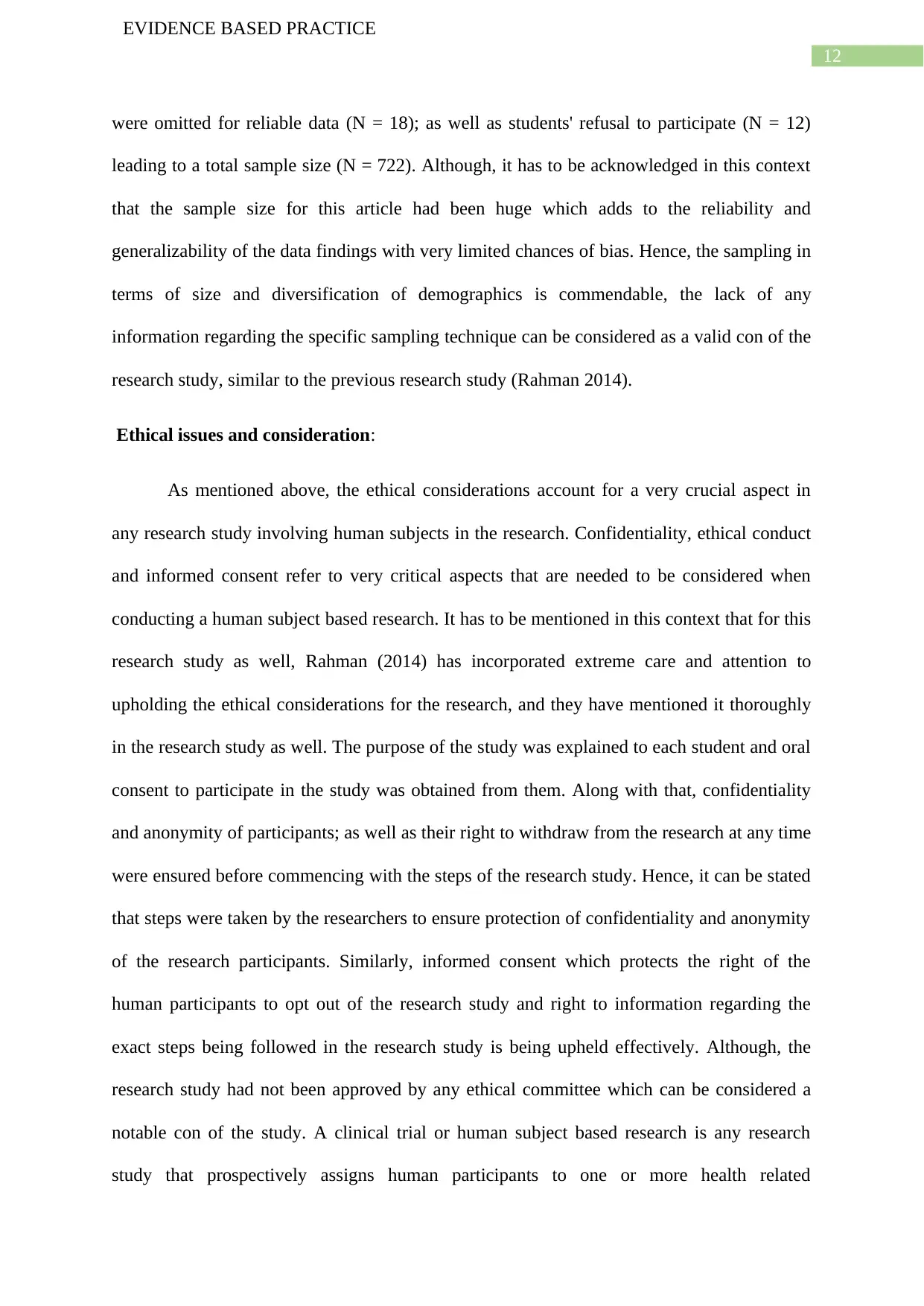
12
EVIDENCE BASED PRACTICE
were omitted for reliable data (N = 18); as well as students' refusal to participate (N = 12)
leading to a total sample size (N = 722). Although, it has to be acknowledged in this context
that the sample size for this article had been huge which adds to the reliability and
generalizability of the data findings with very limited chances of bias. Hence, the sampling in
terms of size and diversification of demographics is commendable, the lack of any
information regarding the specific sampling technique can be considered as a valid con of the
research study, similar to the previous research study (Rahman 2014).
Ethical issues and consideration:
As mentioned above, the ethical considerations account for a very crucial aspect in
any research study involving human subjects in the research. Confidentiality, ethical conduct
and informed consent refer to very critical aspects that are needed to be considered when
conducting a human subject based research. It has to be mentioned in this context that for this
research study as well, Rahman (2014) has incorporated extreme care and attention to
upholding the ethical considerations for the research, and they have mentioned it thoroughly
in the research study as well. The purpose of the study was explained to each student and oral
consent to participate in the study was obtained from them. Along with that, confidentiality
and anonymity of participants; as well as their right to withdraw from the research at any time
were ensured before commencing with the steps of the research study. Hence, it can be stated
that steps were taken by the researchers to ensure protection of confidentiality and anonymity
of the research participants. Similarly, informed consent which protects the right of the
human participants to opt out of the research study and right to information regarding the
exact steps being followed in the research study is being upheld effectively. Although, the
research study had not been approved by any ethical committee which can be considered a
notable con of the study. A clinical trial or human subject based research is any research
study that prospectively assigns human participants to one or more health related
EVIDENCE BASED PRACTICE
were omitted for reliable data (N = 18); as well as students' refusal to participate (N = 12)
leading to a total sample size (N = 722). Although, it has to be acknowledged in this context
that the sample size for this article had been huge which adds to the reliability and
generalizability of the data findings with very limited chances of bias. Hence, the sampling in
terms of size and diversification of demographics is commendable, the lack of any
information regarding the specific sampling technique can be considered as a valid con of the
research study, similar to the previous research study (Rahman 2014).
Ethical issues and consideration:
As mentioned above, the ethical considerations account for a very crucial aspect in
any research study involving human subjects in the research. Confidentiality, ethical conduct
and informed consent refer to very critical aspects that are needed to be considered when
conducting a human subject based research. It has to be mentioned in this context that for this
research study as well, Rahman (2014) has incorporated extreme care and attention to
upholding the ethical considerations for the research, and they have mentioned it thoroughly
in the research study as well. The purpose of the study was explained to each student and oral
consent to participate in the study was obtained from them. Along with that, confidentiality
and anonymity of participants; as well as their right to withdraw from the research at any time
were ensured before commencing with the steps of the research study. Hence, it can be stated
that steps were taken by the researchers to ensure protection of confidentiality and anonymity
of the research participants. Similarly, informed consent which protects the right of the
human participants to opt out of the research study and right to information regarding the
exact steps being followed in the research study is being upheld effectively. Although, the
research study had not been approved by any ethical committee which can be considered a
notable con of the study. A clinical trial or human subject based research is any research
study that prospectively assigns human participants to one or more health related
Paraphrase This Document
Need a fresh take? Get an instant paraphrase of this document with our AI Paraphraser
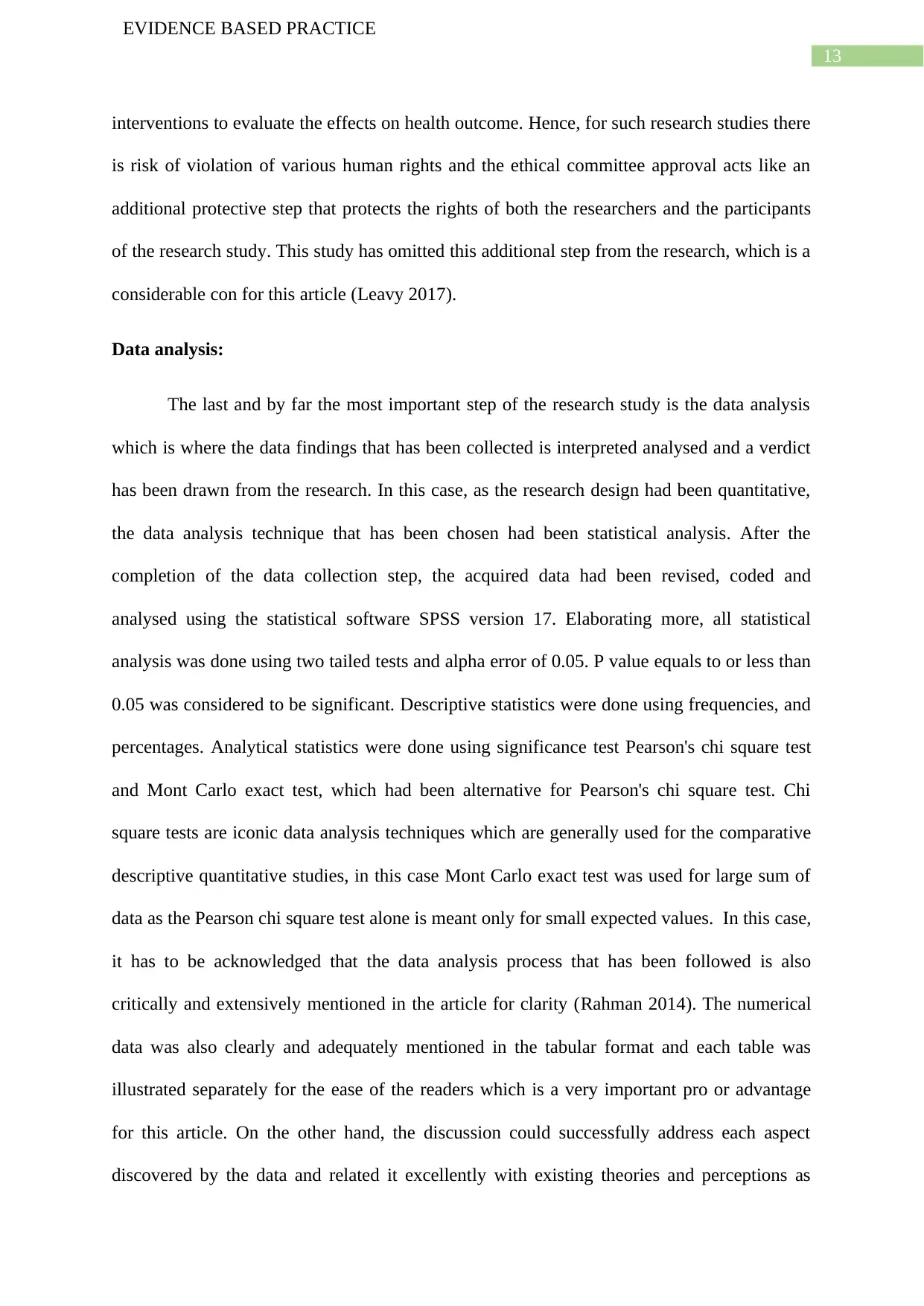
13
EVIDENCE BASED PRACTICE
interventions to evaluate the effects on health outcome. Hence, for such research studies there
is risk of violation of various human rights and the ethical committee approval acts like an
additional protective step that protects the rights of both the researchers and the participants
of the research study. This study has omitted this additional step from the research, which is a
considerable con for this article (Leavy 2017).
Data analysis:
The last and by far the most important step of the research study is the data analysis
which is where the data findings that has been collected is interpreted analysed and a verdict
has been drawn from the research. In this case, as the research design had been quantitative,
the data analysis technique that has been chosen had been statistical analysis. After the
completion of the data collection step, the acquired data had been revised, coded and
analysed using the statistical software SPSS version 17. Elaborating more, all statistical
analysis was done using two tailed tests and alpha error of 0.05. P value equals to or less than
0.05 was considered to be significant. Descriptive statistics were done using frequencies, and
percentages. Analytical statistics were done using significance test Pearson's chi square test
and Mont Carlo exact test, which had been alternative for Pearson's chi square test. Chi
square tests are iconic data analysis techniques which are generally used for the comparative
descriptive quantitative studies, in this case Mont Carlo exact test was used for large sum of
data as the Pearson chi square test alone is meant only for small expected values. In this case,
it has to be acknowledged that the data analysis process that has been followed is also
critically and extensively mentioned in the article for clarity (Rahman 2014). The numerical
data was also clearly and adequately mentioned in the tabular format and each table was
illustrated separately for the ease of the readers which is a very important pro or advantage
for this article. On the other hand, the discussion could successfully address each aspect
discovered by the data and related it excellently with existing theories and perceptions as
EVIDENCE BASED PRACTICE
interventions to evaluate the effects on health outcome. Hence, for such research studies there
is risk of violation of various human rights and the ethical committee approval acts like an
additional protective step that protects the rights of both the researchers and the participants
of the research study. This study has omitted this additional step from the research, which is a
considerable con for this article (Leavy 2017).
Data analysis:
The last and by far the most important step of the research study is the data analysis
which is where the data findings that has been collected is interpreted analysed and a verdict
has been drawn from the research. In this case, as the research design had been quantitative,
the data analysis technique that has been chosen had been statistical analysis. After the
completion of the data collection step, the acquired data had been revised, coded and
analysed using the statistical software SPSS version 17. Elaborating more, all statistical
analysis was done using two tailed tests and alpha error of 0.05. P value equals to or less than
0.05 was considered to be significant. Descriptive statistics were done using frequencies, and
percentages. Analytical statistics were done using significance test Pearson's chi square test
and Mont Carlo exact test, which had been alternative for Pearson's chi square test. Chi
square tests are iconic data analysis techniques which are generally used for the comparative
descriptive quantitative studies, in this case Mont Carlo exact test was used for large sum of
data as the Pearson chi square test alone is meant only for small expected values. In this case,
it has to be acknowledged that the data analysis process that has been followed is also
critically and extensively mentioned in the article for clarity (Rahman 2014). The numerical
data was also clearly and adequately mentioned in the tabular format and each table was
illustrated separately for the ease of the readers which is a very important pro or advantage
for this article. On the other hand, the discussion could successfully address each aspect
discovered by the data and related it excellently with existing theories and perceptions as
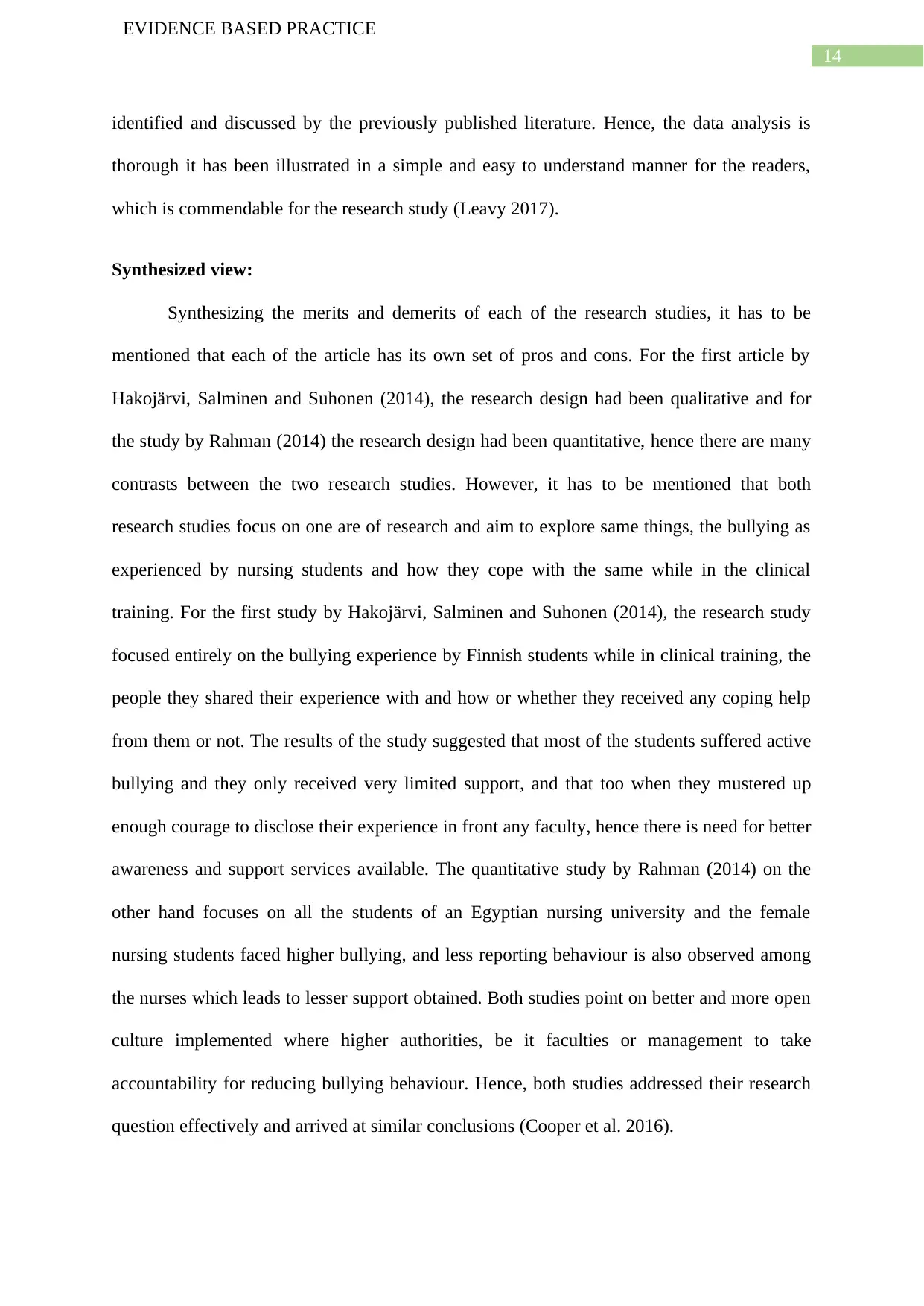
14
EVIDENCE BASED PRACTICE
identified and discussed by the previously published literature. Hence, the data analysis is
thorough it has been illustrated in a simple and easy to understand manner for the readers,
which is commendable for the research study (Leavy 2017).
Synthesized view:
Synthesizing the merits and demerits of each of the research studies, it has to be
mentioned that each of the article has its own set of pros and cons. For the first article by
Hakojärvi, Salminen and Suhonen (2014), the research design had been qualitative and for
the study by Rahman (2014) the research design had been quantitative, hence there are many
contrasts between the two research studies. However, it has to be mentioned that both
research studies focus on one are of research and aim to explore same things, the bullying as
experienced by nursing students and how they cope with the same while in the clinical
training. For the first study by Hakojärvi, Salminen and Suhonen (2014), the research study
focused entirely on the bullying experience by Finnish students while in clinical training, the
people they shared their experience with and how or whether they received any coping help
from them or not. The results of the study suggested that most of the students suffered active
bullying and they only received very limited support, and that too when they mustered up
enough courage to disclose their experience in front any faculty, hence there is need for better
awareness and support services available. The quantitative study by Rahman (2014) on the
other hand focuses on all the students of an Egyptian nursing university and the female
nursing students faced higher bullying, and less reporting behaviour is also observed among
the nurses which leads to lesser support obtained. Both studies point on better and more open
culture implemented where higher authorities, be it faculties or management to take
accountability for reducing bullying behaviour. Hence, both studies addressed their research
question effectively and arrived at similar conclusions (Cooper et al. 2016).
EVIDENCE BASED PRACTICE
identified and discussed by the previously published literature. Hence, the data analysis is
thorough it has been illustrated in a simple and easy to understand manner for the readers,
which is commendable for the research study (Leavy 2017).
Synthesized view:
Synthesizing the merits and demerits of each of the research studies, it has to be
mentioned that each of the article has its own set of pros and cons. For the first article by
Hakojärvi, Salminen and Suhonen (2014), the research design had been qualitative and for
the study by Rahman (2014) the research design had been quantitative, hence there are many
contrasts between the two research studies. However, it has to be mentioned that both
research studies focus on one are of research and aim to explore same things, the bullying as
experienced by nursing students and how they cope with the same while in the clinical
training. For the first study by Hakojärvi, Salminen and Suhonen (2014), the research study
focused entirely on the bullying experience by Finnish students while in clinical training, the
people they shared their experience with and how or whether they received any coping help
from them or not. The results of the study suggested that most of the students suffered active
bullying and they only received very limited support, and that too when they mustered up
enough courage to disclose their experience in front any faculty, hence there is need for better
awareness and support services available. The quantitative study by Rahman (2014) on the
other hand focuses on all the students of an Egyptian nursing university and the female
nursing students faced higher bullying, and less reporting behaviour is also observed among
the nurses which leads to lesser support obtained. Both studies point on better and more open
culture implemented where higher authorities, be it faculties or management to take
accountability for reducing bullying behaviour. Hence, both studies addressed their research
question effectively and arrived at similar conclusions (Cooper et al. 2016).
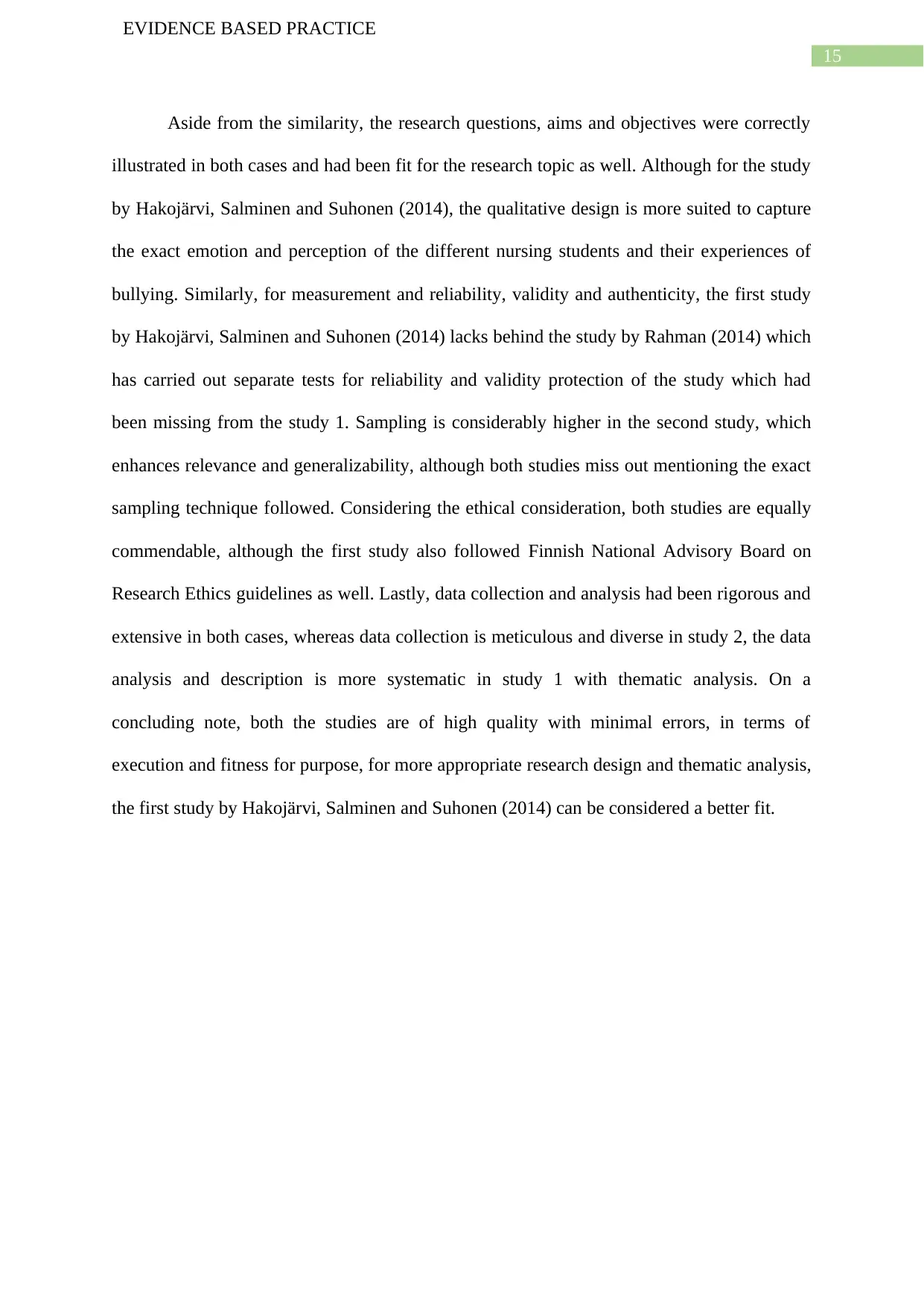
15
EVIDENCE BASED PRACTICE
Aside from the similarity, the research questions, aims and objectives were correctly
illustrated in both cases and had been fit for the research topic as well. Although for the study
by Hakojärvi, Salminen and Suhonen (2014), the qualitative design is more suited to capture
the exact emotion and perception of the different nursing students and their experiences of
bullying. Similarly, for measurement and reliability, validity and authenticity, the first study
by Hakojärvi, Salminen and Suhonen (2014) lacks behind the study by Rahman (2014) which
has carried out separate tests for reliability and validity protection of the study which had
been missing from the study 1. Sampling is considerably higher in the second study, which
enhances relevance and generalizability, although both studies miss out mentioning the exact
sampling technique followed. Considering the ethical consideration, both studies are equally
commendable, although the first study also followed Finnish National Advisory Board on
Research Ethics guidelines as well. Lastly, data collection and analysis had been rigorous and
extensive in both cases, whereas data collection is meticulous and diverse in study 2, the data
analysis and description is more systematic in study 1 with thematic analysis. On a
concluding note, both the studies are of high quality with minimal errors, in terms of
execution and fitness for purpose, for more appropriate research design and thematic analysis,
the first study by Hakojärvi, Salminen and Suhonen (2014) can be considered a better fit.
EVIDENCE BASED PRACTICE
Aside from the similarity, the research questions, aims and objectives were correctly
illustrated in both cases and had been fit for the research topic as well. Although for the study
by Hakojärvi, Salminen and Suhonen (2014), the qualitative design is more suited to capture
the exact emotion and perception of the different nursing students and their experiences of
bullying. Similarly, for measurement and reliability, validity and authenticity, the first study
by Hakojärvi, Salminen and Suhonen (2014) lacks behind the study by Rahman (2014) which
has carried out separate tests for reliability and validity protection of the study which had
been missing from the study 1. Sampling is considerably higher in the second study, which
enhances relevance and generalizability, although both studies miss out mentioning the exact
sampling technique followed. Considering the ethical consideration, both studies are equally
commendable, although the first study also followed Finnish National Advisory Board on
Research Ethics guidelines as well. Lastly, data collection and analysis had been rigorous and
extensive in both cases, whereas data collection is meticulous and diverse in study 2, the data
analysis and description is more systematic in study 1 with thematic analysis. On a
concluding note, both the studies are of high quality with minimal errors, in terms of
execution and fitness for purpose, for more appropriate research design and thematic analysis,
the first study by Hakojärvi, Salminen and Suhonen (2014) can be considered a better fit.
Secure Best Marks with AI Grader
Need help grading? Try our AI Grader for instant feedback on your assignments.
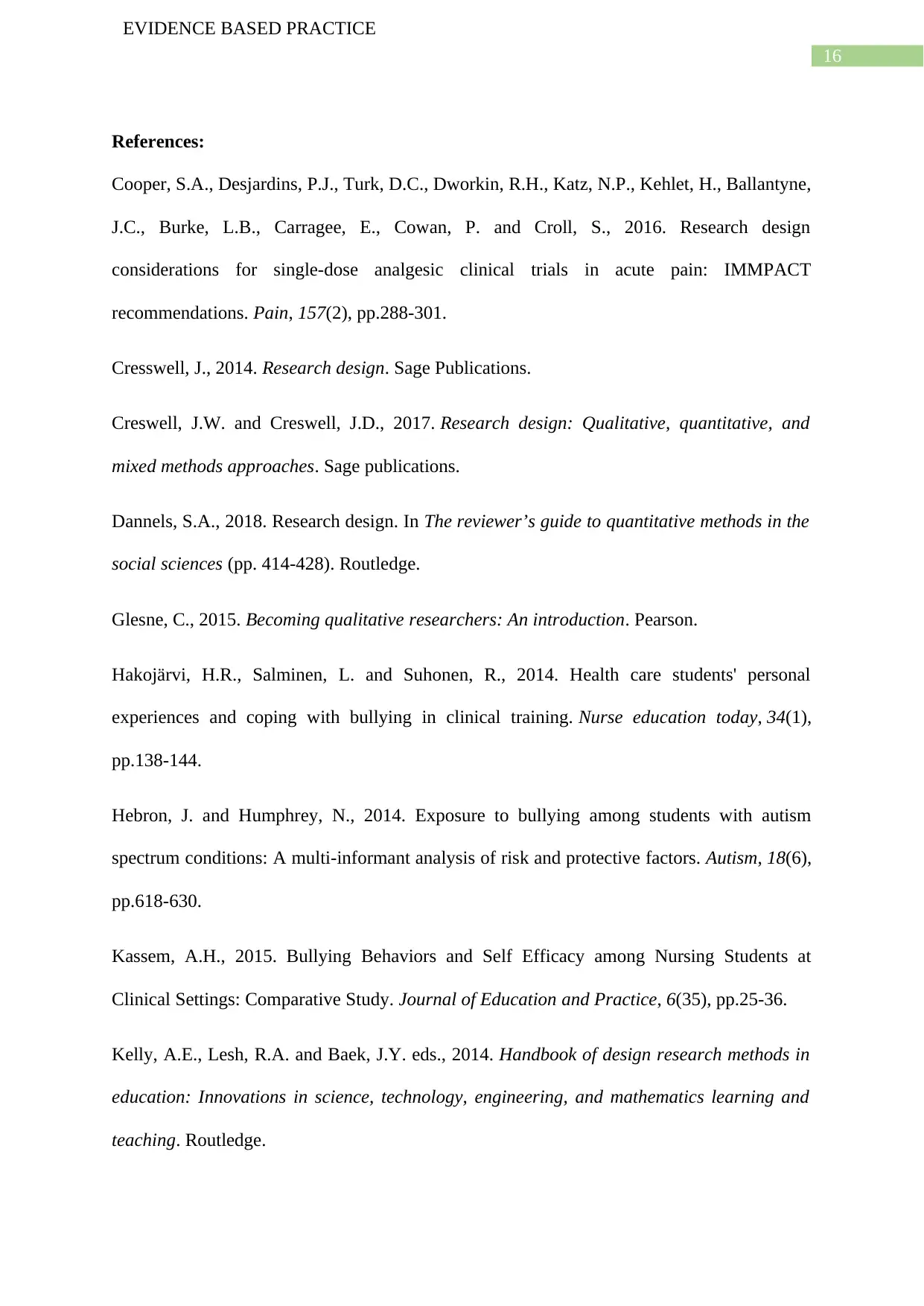
16
EVIDENCE BASED PRACTICE
References:
Cooper, S.A., Desjardins, P.J., Turk, D.C., Dworkin, R.H., Katz, N.P., Kehlet, H., Ballantyne,
J.C., Burke, L.B., Carragee, E., Cowan, P. and Croll, S., 2016. Research design
considerations for single-dose analgesic clinical trials in acute pain: IMMPACT
recommendations. Pain, 157(2), pp.288-301.
Cresswell, J., 2014. Research design. Sage Publications.
Creswell, J.W. and Creswell, J.D., 2017. Research design: Qualitative, quantitative, and
mixed methods approaches. Sage publications.
Dannels, S.A., 2018. Research design. In The reviewer’s guide to quantitative methods in the
social sciences (pp. 414-428). Routledge.
Glesne, C., 2015. Becoming qualitative researchers: An introduction. Pearson.
Hakojärvi, H.R., Salminen, L. and Suhonen, R., 2014. Health care students' personal
experiences and coping with bullying in clinical training. Nurse education today, 34(1),
pp.138-144.
Hebron, J. and Humphrey, N., 2014. Exposure to bullying among students with autism
spectrum conditions: A multi-informant analysis of risk and protective factors. Autism, 18(6),
pp.618-630.
Kassem, A.H., 2015. Bullying Behaviors and Self Efficacy among Nursing Students at
Clinical Settings: Comparative Study. Journal of Education and Practice, 6(35), pp.25-36.
Kelly, A.E., Lesh, R.A. and Baek, J.Y. eds., 2014. Handbook of design research methods in
education: Innovations in science, technology, engineering, and mathematics learning and
teaching. Routledge.
EVIDENCE BASED PRACTICE
References:
Cooper, S.A., Desjardins, P.J., Turk, D.C., Dworkin, R.H., Katz, N.P., Kehlet, H., Ballantyne,
J.C., Burke, L.B., Carragee, E., Cowan, P. and Croll, S., 2016. Research design
considerations for single-dose analgesic clinical trials in acute pain: IMMPACT
recommendations. Pain, 157(2), pp.288-301.
Cresswell, J., 2014. Research design. Sage Publications.
Creswell, J.W. and Creswell, J.D., 2017. Research design: Qualitative, quantitative, and
mixed methods approaches. Sage publications.
Dannels, S.A., 2018. Research design. In The reviewer’s guide to quantitative methods in the
social sciences (pp. 414-428). Routledge.
Glesne, C., 2015. Becoming qualitative researchers: An introduction. Pearson.
Hakojärvi, H.R., Salminen, L. and Suhonen, R., 2014. Health care students' personal
experiences and coping with bullying in clinical training. Nurse education today, 34(1),
pp.138-144.
Hebron, J. and Humphrey, N., 2014. Exposure to bullying among students with autism
spectrum conditions: A multi-informant analysis of risk and protective factors. Autism, 18(6),
pp.618-630.
Kassem, A.H., 2015. Bullying Behaviors and Self Efficacy among Nursing Students at
Clinical Settings: Comparative Study. Journal of Education and Practice, 6(35), pp.25-36.
Kelly, A.E., Lesh, R.A. and Baek, J.Y. eds., 2014. Handbook of design research methods in
education: Innovations in science, technology, engineering, and mathematics learning and
teaching. Routledge.
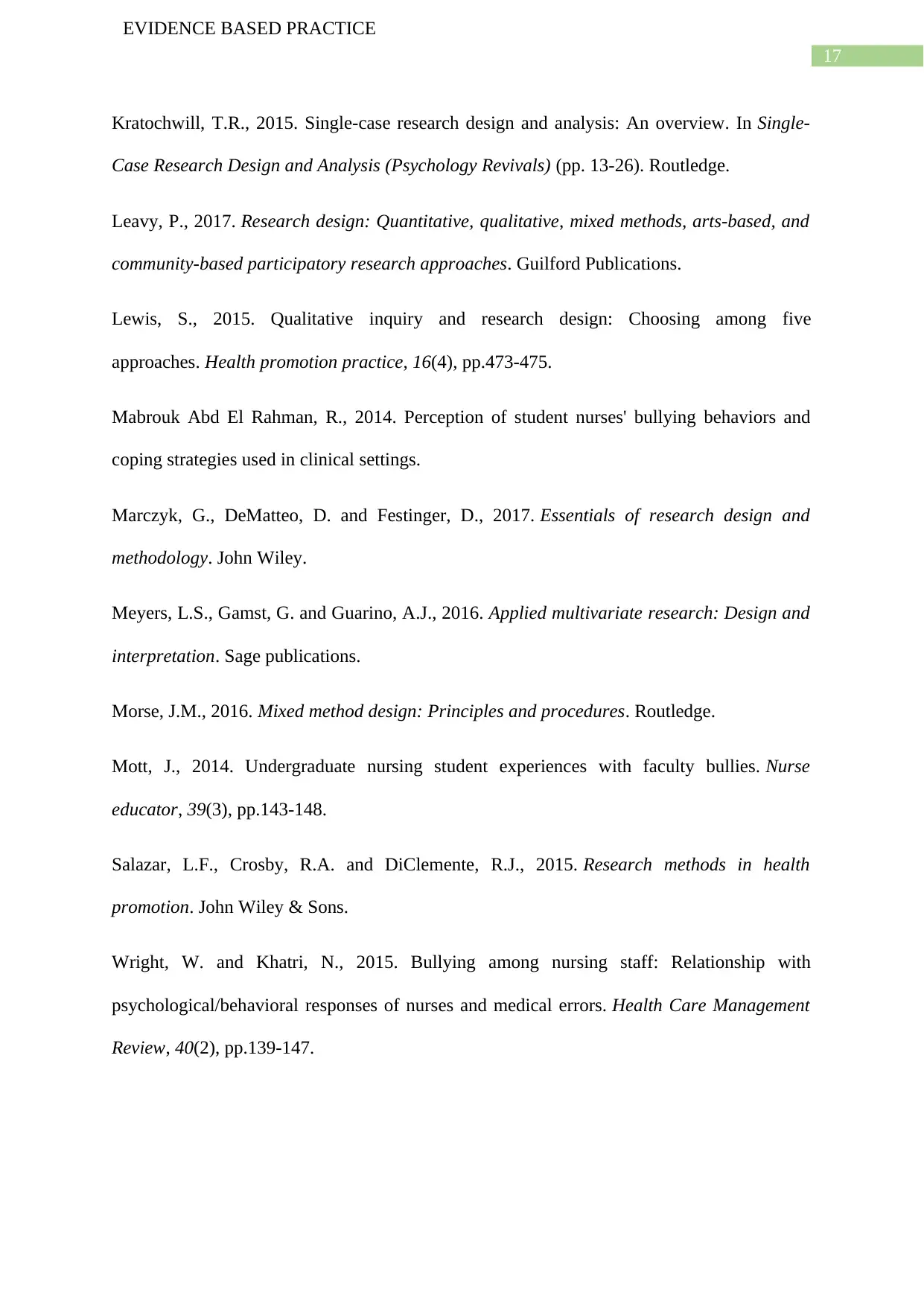
17
EVIDENCE BASED PRACTICE
Kratochwill, T.R., 2015. Single-case research design and analysis: An overview. In Single-
Case Research Design and Analysis (Psychology Revivals) (pp. 13-26). Routledge.
Leavy, P., 2017. Research design: Quantitative, qualitative, mixed methods, arts-based, and
community-based participatory research approaches. Guilford Publications.
Lewis, S., 2015. Qualitative inquiry and research design: Choosing among five
approaches. Health promotion practice, 16(4), pp.473-475.
Mabrouk Abd El Rahman, R., 2014. Perception of student nurses' bullying behaviors and
coping strategies used in clinical settings.
Marczyk, G., DeMatteo, D. and Festinger, D., 2017. Essentials of research design and
methodology. John Wiley.
Meyers, L.S., Gamst, G. and Guarino, A.J., 2016. Applied multivariate research: Design and
interpretation. Sage publications.
Morse, J.M., 2016. Mixed method design: Principles and procedures. Routledge.
Mott, J., 2014. Undergraduate nursing student experiences with faculty bullies. Nurse
educator, 39(3), pp.143-148.
Salazar, L.F., Crosby, R.A. and DiClemente, R.J., 2015. Research methods in health
promotion. John Wiley & Sons.
Wright, W. and Khatri, N., 2015. Bullying among nursing staff: Relationship with
psychological/behavioral responses of nurses and medical errors. Health Care Management
Review, 40(2), pp.139-147.
EVIDENCE BASED PRACTICE
Kratochwill, T.R., 2015. Single-case research design and analysis: An overview. In Single-
Case Research Design and Analysis (Psychology Revivals) (pp. 13-26). Routledge.
Leavy, P., 2017. Research design: Quantitative, qualitative, mixed methods, arts-based, and
community-based participatory research approaches. Guilford Publications.
Lewis, S., 2015. Qualitative inquiry and research design: Choosing among five
approaches. Health promotion practice, 16(4), pp.473-475.
Mabrouk Abd El Rahman, R., 2014. Perception of student nurses' bullying behaviors and
coping strategies used in clinical settings.
Marczyk, G., DeMatteo, D. and Festinger, D., 2017. Essentials of research design and
methodology. John Wiley.
Meyers, L.S., Gamst, G. and Guarino, A.J., 2016. Applied multivariate research: Design and
interpretation. Sage publications.
Morse, J.M., 2016. Mixed method design: Principles and procedures. Routledge.
Mott, J., 2014. Undergraduate nursing student experiences with faculty bullies. Nurse
educator, 39(3), pp.143-148.
Salazar, L.F., Crosby, R.A. and DiClemente, R.J., 2015. Research methods in health
promotion. John Wiley & Sons.
Wright, W. and Khatri, N., 2015. Bullying among nursing staff: Relationship with
psychological/behavioral responses of nurses and medical errors. Health Care Management
Review, 40(2), pp.139-147.

18
EVIDENCE BASED PRACTICE
Wright, W. and Khatri, N., 2015. Bullying among nursing staff: Relationship with
psychological/behavioral responses of nurses and medical errors. Health Care Management
Review, 40(2), pp.139-147.
EVIDENCE BASED PRACTICE
Wright, W. and Khatri, N., 2015. Bullying among nursing staff: Relationship with
psychological/behavioral responses of nurses and medical errors. Health Care Management
Review, 40(2), pp.139-147.
1 out of 19
Related Documents
Your All-in-One AI-Powered Toolkit for Academic Success.
+13062052269
info@desklib.com
Available 24*7 on WhatsApp / Email
![[object Object]](/_next/static/media/star-bottom.7253800d.svg)
Unlock your academic potential
© 2024 | Zucol Services PVT LTD | All rights reserved.





